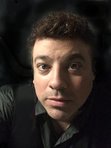Lonnie Ostrow's Blog
August 15, 2017
Magical Memories Of Paul Simon���s Concert In The Park

It���s one of those days that you never forget. August 15, 1991. I was twenty, having just wrapped up a pair of classes at Adelphi University. All summer long I had this date marked on my calendar. Paul Simon���s epic free concert on the Great Lawn in Central Park. And then the day finally arrived. My excitement was in overdrive.
It was warm and sunny when I awoke early that morning. Hastily I packed a bag with a few essentials, grabbed some cash, an umbrella (in the event of forecasted rain) and a pair of sunglasses, then hurried to catch a train to Manhattan and meet up with a trio of friends.
 The Central Park concert: The ultimate gig for any musician. I had seen a handful of them on television in years past. There was the big Simon & Garfunkel reunion back in 1981 which drew half a million people. A show so legendary that it was that it still being rebroadcast on PBS stations a decade later. Elton John had packed the Great Lawn one September earlier for a massive freebie extravaganza. Diana Ross got her showcase in July of 1983, although her initial attempt was curtailed by a severe rainstorm. Her make-up show the next evening enjoyed good weather, but was marred by a crime spree that resulted in Central Park concerts being off-limits for the next seven years ��� the Philharmonic notwithstanding.
The Central Park concert: The ultimate gig for any musician. I had seen a handful of them on television in years past. There was the big Simon & Garfunkel reunion back in 1981 which drew half a million people. A show so legendary that it was that it still being rebroadcast on PBS stations a decade later. Elton John had packed the Great Lawn one September earlier for a massive freebie extravaganza. Diana Ross got her showcase in July of 1983, although her initial attempt was curtailed by a severe rainstorm. Her make-up show the next evening enjoyed good weather, but was marred by a crime spree that resulted in Central Park concerts being off-limits for the next seven years ��� the Philharmonic notwithstanding.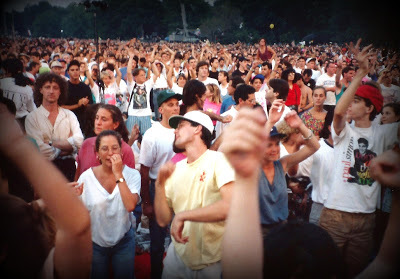 My novel, Poet Of The Wrong Generation opens with our protagonist, Johnny Elias, and his friends rushing into Central Park to grab a prime viewing location for Paul Simon���s 1991 concert in the park. Chapter one gives readers a glimpse into the lives of our four main characters, while spotlighting what was to be the best day of their young lives. All the sights, sounds and aromas are carefully reconstructed through the perspective of Johnny Elias. I guess one could say that having experienced that monumental episode in person, it wasn���t too difficult to transfer my experiences into fiction.
My novel, Poet Of The Wrong Generation opens with our protagonist, Johnny Elias, and his friends rushing into Central Park to grab a prime viewing location for Paul Simon���s 1991 concert in the park. Chapter one gives readers a glimpse into the lives of our four main characters, while spotlighting what was to be the best day of their young lives. All the sights, sounds and aromas are carefully reconstructed through the perspective of Johnny Elias. I guess one could say that having experienced that monumental episode in person, it wasn���t too difficult to transfer my experiences into fiction.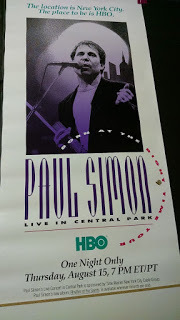 The concert that evening by Paul Simon was quite the spectacle. Long before he and his band took the stage was a full-day of unforgettable memories. First was the quest to get somewhere in the vicinity of the stage. When I arrived with my friends in the park that late morning there were already thousands of people camped out on the Great Lawn. I would soon learn that some of them had been holding down spots for two days or more. A handful had even brought sleeping bags!
The concert that evening by Paul Simon was quite the spectacle. Long before he and his band took the stage was a full-day of unforgettable memories. First was the quest to get somewhere in the vicinity of the stage. When I arrived with my friends in the park that late morning there were already thousands of people camped out on the Great Lawn. I would soon learn that some of them had been holding down spots for two days or more. A handful had even brought sleeping bags!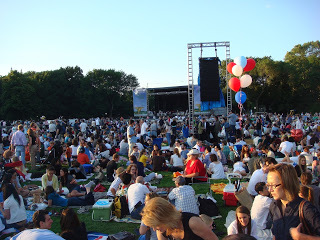 My comrades and I navigated the crowded lawn for close to an hour in search of the best possible sightline. Several seemingly unoccupied spots quickly became a point of contention when others in the vicinity claimed to be ���holding it��� for invisible friends who would soon return. Eventually, we settled on a patch of lawn that was approximately 30 rows (if there were actual rows) from the stage area, just right of center. We spread out a blanket and put down our bags and a cooler.
My comrades and I navigated the crowded lawn for close to an hour in search of the best possible sightline. Several seemingly unoccupied spots quickly became a point of contention when others in the vicinity claimed to be ���holding it��� for invisible friends who would soon return. Eventually, we settled on a patch of lawn that was approximately 30 rows (if there were actual rows) from the stage area, just right of center. We spread out a blanket and put down our bags and a cooler.All around us were scores of music fans of varying ages filled with anticipation. Many of them were New Yorkers who had taken a day from work to attend. Some had driven in from Jersey, Long Island, Philly, DC and even as far as Montreal. There were countless twenty-somethings like us, but also plenty of folks old enough to remember seeing Simon and Garfunkel at Forest Hill Tennis Stadium back in 1970. The t-shirts worn by many that afternoon were a visual history of Paul Simon���s concert tours through the decades.
Boom boxes situated on beach blankets in all directions blared competing music, mostly the classic rock stations of that era: 92.3 K-Rock and 102.7 WNEW. Rather than annoying, the blend of music created a symphony of sounds that would provide a unique soundtrack for the balance of the afternoon. Footballs and Frisbees were being tossed in all directions. My friends and I joined in on a few games of catch, yet always with at least one of us on the blanket at all times to ensure that our prime real-estate wasn���t claimed by late-comers.
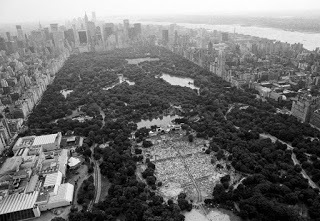 By mid-day, the summer sunshine had become rather oppressive. The high temperature that day was 91 in the shade. On the Great Lawn ��� with no shade in sight ��� the weather was downright steamy. At least the dreaded forecast of rain was thankfully incorrect. My friends and I took turns making runs through the crowd to the vending carts on 5th Avenue to purchase frozen lemonade. But as the massive crowd swelled by 3pm, we were pretty well locked in place. A huge police presence began to gather and instructed all to stay in their roped-off sections. It's a minor miracle that a few unauthorized t-shirt vendors managed to sneak through, displaying mostly professional-looking apparel that fans grabbed for $10 a piece.
By mid-day, the summer sunshine had become rather oppressive. The high temperature that day was 91 in the shade. On the Great Lawn ��� with no shade in sight ��� the weather was downright steamy. At least the dreaded forecast of rain was thankfully incorrect. My friends and I took turns making runs through the crowd to the vending carts on 5th Avenue to purchase frozen lemonade. But as the massive crowd swelled by 3pm, we were pretty well locked in place. A huge police presence began to gather and instructed all to stay in their roped-off sections. It's a minor miracle that a few unauthorized t-shirt vendors managed to sneak through, displaying mostly professional-looking apparel that fans grabbed for $10 a piece.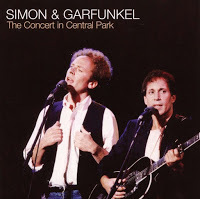 I recall snippets of many conversations that I enjoyed with random strangers that afternoon. The majority of these centered on classic rock bands, concerts of yesteryear and rumored special guests for the show that evening. If social media had been around in 1991, the word ���Garfunkel��� would have been hash-tagged and seriously trending. Fans on all corners of the Great Lawn were buzzing with curiosity as to whether Paul Simon���s estranged musical partner might turn up on stage. It would prove to be wishful thinking.
I recall snippets of many conversations that I enjoyed with random strangers that afternoon. The majority of these centered on classic rock bands, concerts of yesteryear and rumored special guests for the show that evening. If social media had been around in 1991, the word ���Garfunkel��� would have been hash-tagged and seriously trending. Fans on all corners of the Great Lawn were buzzing with curiosity as to whether Paul Simon���s estranged musical partner might turn up on stage. It would prove to be wishful thinking.The other aspect of the day that clings to my memory is how friendly and communal the atmosphere was. So long as you didn���t infringe on someone else���s ���reserved��� space, the surrounding masses were delightful to be with. There were guys with guitars leading joyful sing-alongs, sun-bathing women sharing tubes of sun-block, and even good-natured police officers offering directions to the nearest porta potty. Some groups engaged in elaborate wine and cheese picnics. Others kept cool by consuming whatever cold beverage they could get their hands on.
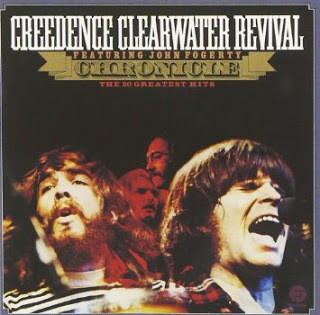 A trivial fact from that glorious afternoon was that Paul Simon had a spectacular, unofficial opening act ��� albeit pre-recorded. Somewhere around 2:00 the sound engineers decided to test the audio system by blaring the greatest hits album of Credence Clearwater Revival. Within mere seconds of the opening chords of Up And Around The Bend, thousands of sun worshipers were up on their feet, singing dancing and clapping along with the music. And with each CCR hit that followed, the sing-along grew louder and more passionate. It was rock & roll nirvana, only a lot more tuneful than Kurt Cobain.
A trivial fact from that glorious afternoon was that Paul Simon had a spectacular, unofficial opening act ��� albeit pre-recorded. Somewhere around 2:00 the sound engineers decided to test the audio system by blaring the greatest hits album of Credence Clearwater Revival. Within mere seconds of the opening chords of Up And Around The Bend, thousands of sun worshipers were up on their feet, singing dancing and clapping along with the music. And with each CCR hit that followed, the sing-along grew louder and more passionate. It was rock & roll nirvana, only a lot more tuneful than Kurt Cobain.Estimates on the size of the crowd that day ranged anywhere from half-a-million to 750,000. I���m not sure whose job it was to count that day, but overhead images and video sure make it look like the largest audience ever assembled at a New York City concert. It was a startling mass of humanity. Giant video projection screens and dozens of speaker-towers were assembled at the halfway point of the jam-packed lawn to enable scores of attendees to see and hear the performance. Anyone who dared to enter the park after 5pm was relegated to experiencing the show via audio/video technology.
It was somewhere around 7:30pm when the other opening act took center stage. A parade of New York politicians were introduced to the mammoth crowd, who responded with a chorus of boos. It wasn���t politically motivated ��� just a bunch of overheated music fans waiting to be entertained by one of their great generational heroes. Speeches and photo-ops by elected officials were sorely out of place. The harshest reception was reserved for Mayor David Dinkins. New York City���s 106th head-honcho was soundly jeered when he stepped up to the microphone. But he exited to thunderous cheers after enthusiastically introducing the star attraction.
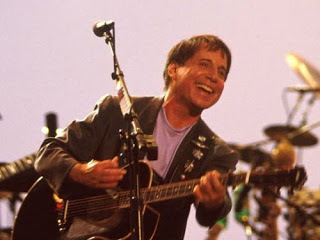 More than half a million people all rose to their collective feet. The roar of the crowd was ear-splitting. The opening song was Paul Simon���s latest radio single, The Obvious Child. It featured a row of ten Brazilian percussionists with tri-colored drums standing elevated behind the eight piece band. Quite the colorful spectacle.
More than half a million people all rose to their collective feet. The roar of the crowd was ear-splitting. The opening song was Paul Simon���s latest radio single, The Obvious Child. It featured a row of ten Brazilian percussionists with tri-colored drums standing elevated behind the eight piece band. Quite the colorful spectacle.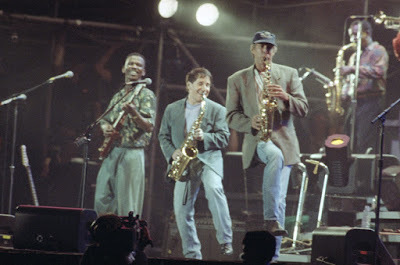 The balance of the show was a blend of 23 songs cherry-picked from Mr. Simon���s immense catalog of classics. Several were from his Graceland album, most memorably You Can Call Me Al (featuring a guest dance appearance by Chevy Chase). Early solo hits included Slip Sliding Away, Late In The Evening, and Kodachrome.And of course there was his legendary Simon & Garfunkel nuggets, Bridge Over Troubled Water, America, Cecilia and The Boxer. Though many of these timeless tunes had been released in the decade before I was born, I had been fortunately raised on them by my Mom. She and I used to harmonize with these songs in our living room when she played them on her stereo record player. They���ve fondly stayed with me ever since.
The balance of the show was a blend of 23 songs cherry-picked from Mr. Simon���s immense catalog of classics. Several were from his Graceland album, most memorably You Can Call Me Al (featuring a guest dance appearance by Chevy Chase). Early solo hits included Slip Sliding Away, Late In The Evening, and Kodachrome.And of course there was his legendary Simon & Garfunkel nuggets, Bridge Over Troubled Water, America, Cecilia and The Boxer. Though many of these timeless tunes had been released in the decade before I was born, I had been fortunately raised on them by my Mom. She and I used to harmonize with these songs in our living room when she played them on her stereo record player. They���ve fondly stayed with me ever since. 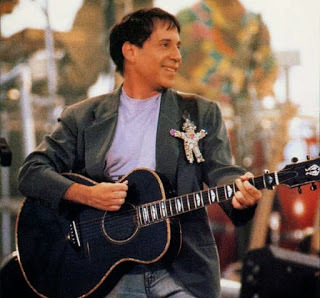 A big personal highlight that night was the performance of Me And Julio Down By The Schoolyard. This up-tempo acoustic tune had the masses up and dancing around. One could hear the song perfectly, although our view of the stage was now obscured. Many of the men in front of us began hoisting their female companions up on their shoulders. Spontaneously, I bent down and offered to lift my friend Kenny up above the crowd. I didn't think he would take me up on it. The man is approximately six foot two and weighed around 200 pounds back in the day. He looked terrified when I suggested the idea. But after a shrug and a moment to think it over, he leaped up on my back, swung his legs over my shoulders and steadied himself. Adrenaline enabled me to keep him there for the duration of the song. Given our proximity to the stage one can actually catch a quick glimpse of his dark curly hair high above the masses in some of the audience shots from the HBO broadcast. Our shining moment of concert immortality, or so we boasted for the past 26 years.
A big personal highlight that night was the performance of Me And Julio Down By The Schoolyard. This up-tempo acoustic tune had the masses up and dancing around. One could hear the song perfectly, although our view of the stage was now obscured. Many of the men in front of us began hoisting their female companions up on their shoulders. Spontaneously, I bent down and offered to lift my friend Kenny up above the crowd. I didn't think he would take me up on it. The man is approximately six foot two and weighed around 200 pounds back in the day. He looked terrified when I suggested the idea. But after a shrug and a moment to think it over, he leaped up on my back, swung his legs over my shoulders and steadied himself. Adrenaline enabled me to keep him there for the duration of the song. Given our proximity to the stage one can actually catch a quick glimpse of his dark curly hair high above the masses in some of the audience shots from the HBO broadcast. Our shining moment of concert immortality, or so we boasted for the past 26 years.My novel���s protagonist, Johnny Elias, likened his attendance at Paul Simon���s Central Park concert as the next closest thing to being at Woodstock for those who were too young to attend. No, it did not own the cultural impact of that 1969 music festival in upstate New York. But for the more than half a million people who took part in this one day musical love-fest on the Great Lawn that perfect summer afternoon, they all share in the memory of something truly magical.
Poet Of The Wrong Generation by Lonnie Ostrow is now available in paperback and eBook format.
CLICK HERE TO ORDER YOUR COPY.

Published on August 15, 2017 06:20
Magical Memories Of Paul Simon’s Concert In The Park

It’s one of those days that you never forget. August 15, 1991. I was twenty, having just wrapped up a pair of classes at Adelphi University. All summer long I had this date marked on my calendar. Paul Simon’s epic free concert on the Great Lawn in Central Park. And then the day finally arrived. My excitement was in overdrive.
It was warm and sunny when I awoke early that morning. Hastily I packed a bag with a few essentials, grabbed some cash, an umbrella (in the event of forecasted rain) and a pair of sunglasses, then hurried to catch a train to Manhattan and meet up with a trio of friends.
 The Central Park concert: The ultimate gig for any musician. I had seen a handful of them on television in years past. There was the big Simon & Garfunkel reunion back in 1981 which drew half a million people. A show so legendary that it was that it still being rebroadcast on PBS stations a decade later. Elton John had packed the Great Lawn one September earlier for a massive freebie extravaganza. Diana Ross got her showcase in July of 1983, although her initial attempt was curtailed by a severe rainstorm. Her make-up show the next evening enjoyed good weather, but was marred by a crime spree that resulted in Central Park concerts being off-limits for the next seven years – the Philharmonic notwithstanding.
The Central Park concert: The ultimate gig for any musician. I had seen a handful of them on television in years past. There was the big Simon & Garfunkel reunion back in 1981 which drew half a million people. A show so legendary that it was that it still being rebroadcast on PBS stations a decade later. Elton John had packed the Great Lawn one September earlier for a massive freebie extravaganza. Diana Ross got her showcase in July of 1983, although her initial attempt was curtailed by a severe rainstorm. Her make-up show the next evening enjoyed good weather, but was marred by a crime spree that resulted in Central Park concerts being off-limits for the next seven years – the Philharmonic notwithstanding. My novel, Poet Of The Wrong Generation opens with our protagonist, Johnny Elias, and his friends rushing into Central Park to grab a prime viewing location for Paul Simon’s 1991 concert in the park. Chapter one gives readers a glimpse into the lives of our four main characters, while spotlighting what was to be the best day of their young lives. All the sights, sounds and aromas are carefully reconstructed through the perspective of Johnny Elias. I guess one could say that having experienced that monumental episode in person, it wasn’t too difficult to transfer my experiences into fiction.
My novel, Poet Of The Wrong Generation opens with our protagonist, Johnny Elias, and his friends rushing into Central Park to grab a prime viewing location for Paul Simon’s 1991 concert in the park. Chapter one gives readers a glimpse into the lives of our four main characters, while spotlighting what was to be the best day of their young lives. All the sights, sounds and aromas are carefully reconstructed through the perspective of Johnny Elias. I guess one could say that having experienced that monumental episode in person, it wasn’t too difficult to transfer my experiences into fiction. The concert that evening by Paul Simon was quite the spectacle. Long before he and his band took the stage was a full-day of unforgettable memories. First was the quest to get somewhere in the vicinity of the stage. When I arrived with my friends in the park that late morning there were already thousands of people camped out on the Great Lawn. I would soon learn that some of them had been holding down spots for two days or more. A handful had even brought sleeping bags!
The concert that evening by Paul Simon was quite the spectacle. Long before he and his band took the stage was a full-day of unforgettable memories. First was the quest to get somewhere in the vicinity of the stage. When I arrived with my friends in the park that late morning there were already thousands of people camped out on the Great Lawn. I would soon learn that some of them had been holding down spots for two days or more. A handful had even brought sleeping bags! My comrades and I navigated the crowded lawn for close to an hour in search of the best possible sightline. Several seemingly unoccupied spots quickly became a point of contention when others in the vicinity claimed to be “holding it” for invisible friends who would soon return. Eventually, we settled on a patch of lawn that was approximately 30 rows (if there were actual rows) from the stage area, just right of center. We spread out a blanket and put down our bags and a cooler.
My comrades and I navigated the crowded lawn for close to an hour in search of the best possible sightline. Several seemingly unoccupied spots quickly became a point of contention when others in the vicinity claimed to be “holding it” for invisible friends who would soon return. Eventually, we settled on a patch of lawn that was approximately 30 rows (if there were actual rows) from the stage area, just right of center. We spread out a blanket and put down our bags and a cooler.All around us were scores of music fans of varying ages filled with anticipation. Many of them were New Yorkers who had taken a day from work to attend. Some had driven in from Jersey, Long Island, Philly, DC and even as far as Montreal. There were countless twenty-somethings like us, but also plenty of folks old enough to remember seeing Simon and Garfunkel at Forest Hill Tennis Stadium back in 1970. The t-shirts worn by many that afternoon were a visual history of Paul Simon’s concert tours through the decades.
Boom boxes situated on beach blankets in all directions blared competing music, mostly the classic rock stations of that era: 92.3 K-Rock and 102.7 WNEW. Rather than annoying, the blend of music created a symphony of sounds that would provide a unique soundtrack for the balance of the afternoon. Footballs and Frisbees were being tossed in all directions. My friends and I joined in on a few games of catch, yet always with at least one of us on the blanket at all times to ensure that our prime real-estate wasn’t claimed by late-comers.
 By mid-day, the summer sunshine had become rather oppressive. The high temperature that day was 91 in the shade. On the Great Lawn – with no shade in sight – the weather was downright steamy. At least the dreaded forecast of rain was thankfully incorrect. My friends and I took turns making runs through the crowd to the vending carts on 5th Avenue to purchase frozen lemonade. But as the massive crowd swelled by 3pm, we were pretty well locked in place. A huge police presence began to gather and instructed all to stay in their roped-off sections. It's a minor miracle that a few unauthorized t-shirt vendors managed to sneak through, displaying mostly professional-looking apparel that fans grabbed for $10 a piece.
By mid-day, the summer sunshine had become rather oppressive. The high temperature that day was 91 in the shade. On the Great Lawn – with no shade in sight – the weather was downright steamy. At least the dreaded forecast of rain was thankfully incorrect. My friends and I took turns making runs through the crowd to the vending carts on 5th Avenue to purchase frozen lemonade. But as the massive crowd swelled by 3pm, we were pretty well locked in place. A huge police presence began to gather and instructed all to stay in their roped-off sections. It's a minor miracle that a few unauthorized t-shirt vendors managed to sneak through, displaying mostly professional-looking apparel that fans grabbed for $10 a piece. I recall snippets of many conversations that I enjoyed with random strangers that afternoon. The majority of these centered on classic rock bands, concerts of yesteryear and rumored special guests for the show that evening. If social media had been around in 1991, the word “Garfunkel” would have been hash-tagged and seriously trending. Fans on all corners of the Great Lawn were buzzing with curiosity as to whether Paul Simon’s estranged musical partner might turn up on stage. It would prove to be wishful thinking.
I recall snippets of many conversations that I enjoyed with random strangers that afternoon. The majority of these centered on classic rock bands, concerts of yesteryear and rumored special guests for the show that evening. If social media had been around in 1991, the word “Garfunkel” would have been hash-tagged and seriously trending. Fans on all corners of the Great Lawn were buzzing with curiosity as to whether Paul Simon’s estranged musical partner might turn up on stage. It would prove to be wishful thinking.The other aspect of the day that clings to my memory is how friendly and communal the atmosphere was. So long as you didn’t infringe on someone else’s “reserved” space, the surrounding masses were delightful to be with. There were guys with guitars leading joyful sing-alongs, sun-bathing women sharing tubes of sun-block, and even good-natured police officers offering directions to the nearest porta potty. Some groups engaged in elaborate wine and cheese picnics. Others kept cool by consuming whatever cold beverage they could get their hands on.
 A trivial fact from that glorious afternoon was that Paul Simon had a spectacular, unofficial opening act – albeit pre-recorded. Somewhere around 2:00 the sound engineers decided to test the audio system by blaring the greatest hits album of Credence Clearwater Revival. Within mere seconds of the opening chords of Up And Around The Bend, thousands of sun worshipers were up on their feet, singing dancing and clapping along with the music. And with each CCR hit that followed, the sing-along grew louder and more passionate. It was rock & roll nirvana, only a lot more tuneful than Kurt Cobain.
A trivial fact from that glorious afternoon was that Paul Simon had a spectacular, unofficial opening act – albeit pre-recorded. Somewhere around 2:00 the sound engineers decided to test the audio system by blaring the greatest hits album of Credence Clearwater Revival. Within mere seconds of the opening chords of Up And Around The Bend, thousands of sun worshipers were up on their feet, singing dancing and clapping along with the music. And with each CCR hit that followed, the sing-along grew louder and more passionate. It was rock & roll nirvana, only a lot more tuneful than Kurt Cobain.Estimates on the size of the crowd that day ranged anywhere from half-a-million to 750,000. I’m not sure whose job it was to count that day, but overhead images and video sure make it look like the largest audience ever assembled at a New York City concert. It was a startling mass of humanity. Giant video projection screens and dozens of speaker-towers were assembled at the halfway point of the jam-packed lawn to enable scores of attendees to see and hear the performance. Anyone who dared to enter the park after 5pm was relegated to experiencing the show via audio/video technology.
It was somewhere around 7:30pm when the other opening act took center stage. A parade of New York politicians were introduced to the mammoth crowd, who responded with a chorus of boos. It wasn’t politically motivated – just a bunch of overheated music fans waiting to be entertained by one of their great generational heroes. Speeches and photo-ops by elected officials were sorely out of place. The harshest reception was reserved for Mayor David Dinkins. New York City’s 106th head-honcho was soundly jeered when he stepped up to the microphone. But he exited to thunderous cheers after enthusiastically introducing the star attraction.
 More than half a million people all rose to their collective feet. The roar of the crowd was ear-splitting. The opening song was Paul Simon’s latest radio single, The Obvious Child. It featured a row of ten Brazilian percussionists with tri-colored drums standing elevated behind the eight piece band. Quite the colorful spectacle.
More than half a million people all rose to their collective feet. The roar of the crowd was ear-splitting. The opening song was Paul Simon’s latest radio single, The Obvious Child. It featured a row of ten Brazilian percussionists with tri-colored drums standing elevated behind the eight piece band. Quite the colorful spectacle. The balance of the show was a blend of 23 songs cherry-picked from Mr. Simon’s immense catalog of classics. Several were from his Graceland album, most memorably You Can Call Me Al (featuring a guest dance appearance by Chevy Chase). Early solo hits included Slip Sliding Away, Late In The Evening, and Kodachrome.And of course there was his legendary Simon & Garfunkel nuggets, Bridge Over Troubled Water, America, Cecilia and The Boxer. Though many of these timeless tunes had been released in the decade before I was born, I had been fortunately raised on them by my Mom. She and I used to harmonize with these songs in our living room when she played them on her stereo record player. They’ve fondly stayed with me ever since.
The balance of the show was a blend of 23 songs cherry-picked from Mr. Simon’s immense catalog of classics. Several were from his Graceland album, most memorably You Can Call Me Al (featuring a guest dance appearance by Chevy Chase). Early solo hits included Slip Sliding Away, Late In The Evening, and Kodachrome.And of course there was his legendary Simon & Garfunkel nuggets, Bridge Over Troubled Water, America, Cecilia and The Boxer. Though many of these timeless tunes had been released in the decade before I was born, I had been fortunately raised on them by my Mom. She and I used to harmonize with these songs in our living room when she played them on her stereo record player. They’ve fondly stayed with me ever since.  A big personal highlight that night was the performance of Me And Julio Down By The Schoolyard. This up-tempo acoustic tune had the masses up and dancing around. One could hear the song perfectly, although our view of the stage was now obscured. Many of the men in front of us began hoisting their female companions up on their shoulders. Spontaneously, I bent down and offered to lift my friend Kenny up above the crowd. I didn't think he would take me up on it. The man is approximately six foot two and weighed around 200 pounds back in the day. He looked terrified when I suggested the idea. But after a shrug and a moment to think it over, he leaped up on my back, swung his legs over my shoulders and steadied himself. Adrenaline enabled me to keep him there for the duration of the song. Given our proximity to the stage one can actually catch a quick glimpse of his dark curly hair high above the masses in some of the audience shots from the HBO broadcast. Our shining moment of concert immortality, or so we boasted for the past 26 years.
A big personal highlight that night was the performance of Me And Julio Down By The Schoolyard. This up-tempo acoustic tune had the masses up and dancing around. One could hear the song perfectly, although our view of the stage was now obscured. Many of the men in front of us began hoisting their female companions up on their shoulders. Spontaneously, I bent down and offered to lift my friend Kenny up above the crowd. I didn't think he would take me up on it. The man is approximately six foot two and weighed around 200 pounds back in the day. He looked terrified when I suggested the idea. But after a shrug and a moment to think it over, he leaped up on my back, swung his legs over my shoulders and steadied himself. Adrenaline enabled me to keep him there for the duration of the song. Given our proximity to the stage one can actually catch a quick glimpse of his dark curly hair high above the masses in some of the audience shots from the HBO broadcast. Our shining moment of concert immortality, or so we boasted for the past 26 years.My novel’s protagonist, Johnny Elias, likened his attendance at Paul Simon’s Central Park concert as the next closest thing to being at Woodstock for those who were too young to attend. No, it did not own the cultural impact of that 1969 music festival in upstate New York. But for the more than half a million people who took part in this one day musical love-fest on the Great Lawn that perfect summer afternoon, they all share in the memory of something truly magical.
Poet Of The Wrong Generation by Lonnie Ostrow is now available in paperback and eBook format.
CLICK HERE TO ORDER YOUR COPY.

Published on August 15, 2017 06:20
March 28, 2017
Christopher Reeve And The Irony Of Celebrity

It was October of 1978. I was a third grader, infatuated with super heroes, comic books and afternoon cartoons. My friends and I split our playtime between baseball cards, superhero action figures and our Star Wars play-sets. Then came one of childhood's most memorable moments. The "big reveal."
Every Tuesday, our 3rd grade teacher, Mrs. Meshenberg would hand out our Scholastic Weekly Reader newsletter. And in this particular issue, we were going to find out who was picked to play the title role of Superman in the upcoming big screen blockbuster. My friends and I had heard that more than 200 actors had been auditioned for the part. Some of us sat in the playground at recess guessing as to whether the man they picked would look like our comic book hero. And then finally, the moment arrived. Mrs. Meshenberg opened the package of the folded newsletter and handed out a stack to the first person in each row. As the Weekly Readers made their way back, you could hear the turn of the page and the oohs and ahhs of our classmates. The name Christopher Reeve had been purely anonymous to us up to this moment. But that muscular man in the blue spandex and red cape flying over the NY skyline pictured in the center-spread of our newsletter was absolutely perfect. He had the hair, the face, those blue eyes. We were mesmerized.
I carefully packed up my Scholastic newsletter and brought it home for the first and only time. That night I grabbed a scotch tape dispenser from my Dad's desk, unfolded the 2-page spread and carefully hung the mini-poster on my bedroom wall, opposite my bed and just beneath my window. It would hang there for more than a decade, one of the proudest souvenirs of my childhood.
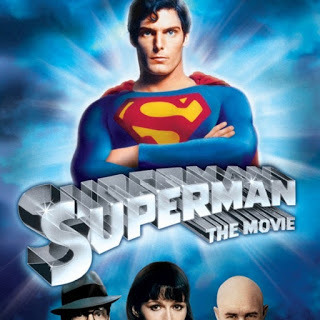 A few months later, my parents took me to see the first Superman movie. My heart was beating out of my chest with anticipation. The movie was loaded with award winning actors including Marlon Brando, Gene Hackman and Ned Beatty. None of them meant anything to me at the time, although Hackman was convincing and excellent as the wicked Lex Luther. But from that day forward, Christopher Reeve became permanently heroic in my life. There would be an excellent sequel a few years later, followed by a watered-down third film and then a train-wreck4th one. I pretty much lost track after that, though I never stopped rooting for Christopher Reeve to remain a success... even when he seemed to have vanished from the public eye.
A few months later, my parents took me to see the first Superman movie. My heart was beating out of my chest with anticipation. The movie was loaded with award winning actors including Marlon Brando, Gene Hackman and Ned Beatty. None of them meant anything to me at the time, although Hackman was convincing and excellent as the wicked Lex Luther. But from that day forward, Christopher Reeve became permanently heroic in my life. There would be an excellent sequel a few years later, followed by a watered-down third film and then a train-wreck4th one. I pretty much lost track after that, though I never stopped rooting for Christopher Reeve to remain a success... even when he seemed to have vanished from the public eye. Flash forward to the spring of 1992. I was a senior, majoring in Communications at Adelphi University in Garden City, NY. This was one morning in March. A memo had been sent from the Theater department to the Communications students, inviting us to join the Theater-Arts majors at a special assembly that afternoon in the Olmstead Theater. It happened that I would be free during that hour, though I was reluctant to give up my study-time for some random, unknown presentation. It was only at the urging of one of my favorite teachers, Professor Helen Stritzler, that I elected to pop in. Suffice to say, it is an hour I will never forget.
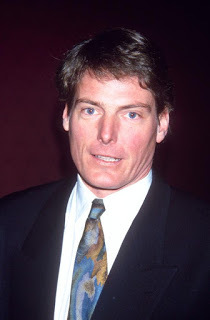 Christopher Reeve in 1992Just after 1pm the overhead lights were dimmed, the stage lights went on and out to the podium walked my boyhood idol, Christopher Reeve. There were some audible gasps from the audience as he approached the microphone. Here was one of the most famous faces of our lifetime, standing just a few feet away, looking every bit as tall, robust and handsome as we remembered him from the big screen. And then he uttered the opening line that stunned the room: "Superman was the greatest thing to ever happen to me. But as an aspiring serious actor, it was also the worst."
Christopher Reeve in 1992Just after 1pm the overhead lights were dimmed, the stage lights went on and out to the podium walked my boyhood idol, Christopher Reeve. There were some audible gasps from the audience as he approached the microphone. Here was one of the most famous faces of our lifetime, standing just a few feet away, looking every bit as tall, robust and handsome as we remembered him from the big screen. And then he uttered the opening line that stunned the room: "Superman was the greatest thing to ever happen to me. But as an aspiring serious actor, it was also the worst." He paused for dramatic effect and watched as jaws dropped collectively around the half-full theater. "I'm here to talk to you today about the subject of typecasting. It is one in which probably no one else is better versed."
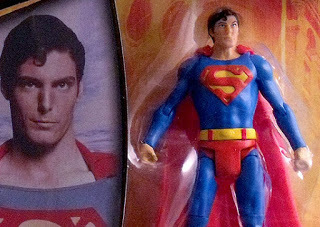 Yes, Christopher Reeve, Superman, the face whose likeness had been turned into a million action figures, made an untold fortune and whose face stared at me from my bedroom wall for a decade was now right in front of me, explaining his "Superman curse." It was a shocking revelation that required clarification, which would soon be forthcoming.
Yes, Christopher Reeve, Superman, the face whose likeness had been turned into a million action figures, made an untold fortune and whose face stared at me from my bedroom wall for a decade was now right in front of me, explaining his "Superman curse." It was a shocking revelation that required clarification, which would soon be forthcoming. 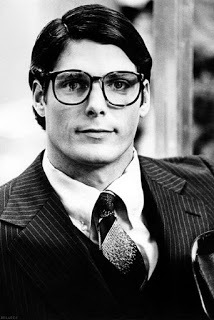 Mr. Reeve told us that the first Superman movie turned him from acting obscurity into an overnight superstar. He talked about the perks of fame, of being recognized on the street, signing autographs wherever he went and getting comped for meals at restaurants. "I was only paid $250,000 combined for those first two Superman movies. Didn't make me rich, but it sure put me on the map. I went from being an actor in training at Julliard to local theater to one of the biggest roles in movie history. It all happened so fast. Doesn't usually happen that way," he said matter-of-factly.
Mr. Reeve told us that the first Superman movie turned him from acting obscurity into an overnight superstar. He talked about the perks of fame, of being recognized on the street, signing autographs wherever he went and getting comped for meals at restaurants. "I was only paid $250,000 combined for those first two Superman movies. Didn't make me rich, but it sure put me on the map. I went from being an actor in training at Julliard to local theater to one of the biggest roles in movie history. It all happened so fast. Doesn't usually happen that way," he said matter-of-factly. For continuity purposes, the first two Superman films were
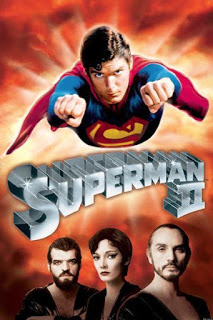 shot consecutively, leaving Reeve little time to pursue other acting roles. But after the release of Superman II, he found that other parts were oddly hard to find. "My agent would send me to auditions and casting directors. And everywhere I heard the same thing. You're too clean, too perfect, too heroic to play this part. No one will buy into it with you being a superhero."
shot consecutively, leaving Reeve little time to pursue other acting roles. But after the release of Superman II, he found that other parts were oddly hard to find. "My agent would send me to auditions and casting directors. And everywhere I heard the same thing. You're too clean, too perfect, too heroic to play this part. No one will buy into it with you being a superhero."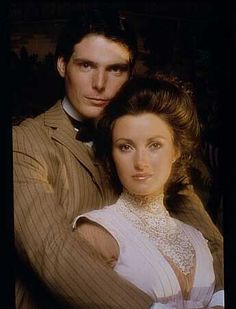 Christopher Reeve & Jane SeymourHe went on to explain how he tried to land roles that would enable him to distance himself from the ultra-good guy. A role in a low-budget romantic fantasy film, Somewhere In Time opposite Jane Seymour seemed to be the departure he was seeking. But an actor's union strike prevented him from promoting the film and it was in and out of the theaters in only 3 weeks. When other lead roles in movies eluded him, Reeve left Hollywood and moved to Boston, where he starred in a theatrical play. This led him to a role on Broadway in a productioncalled The Fifth Of July. Reviewers praised his performance. For his next film role, Reeve managed to land the part of a homicidal playwright in the film, Death Trap. He said of that turn: "I wanted to play a morally ambiguous character who was neither clearly good nor clearly bad, someone to whom life is much more complex than the characters I've played previously." He earned praise for his portrayal, though again the movie proved another box office failure. And with few viable options for his next big opportunity, Reeve agreed to again don the spandex for another turn as the man of steel in Superman III.
Christopher Reeve & Jane SeymourHe went on to explain how he tried to land roles that would enable him to distance himself from the ultra-good guy. A role in a low-budget romantic fantasy film, Somewhere In Time opposite Jane Seymour seemed to be the departure he was seeking. But an actor's union strike prevented him from promoting the film and it was in and out of the theaters in only 3 weeks. When other lead roles in movies eluded him, Reeve left Hollywood and moved to Boston, where he starred in a theatrical play. This led him to a role on Broadway in a productioncalled The Fifth Of July. Reviewers praised his performance. For his next film role, Reeve managed to land the part of a homicidal playwright in the film, Death Trap. He said of that turn: "I wanted to play a morally ambiguous character who was neither clearly good nor clearly bad, someone to whom life is much more complex than the characters I've played previously." He earned praise for his portrayal, though again the movie proved another box office failure. And with few viable options for his next big opportunity, Reeve agreed to again don the spandex for another turn as the man of steel in Superman III. 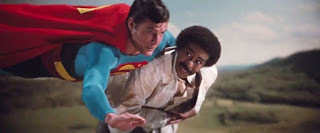 Christopher Reeve and Richard Pryor in Superman III"This time, the money was there. Well over a million dollars, plus merchandising royalties. It wasn't a great film, but it made me wealthy beyond my dreams. If I didn't still consider myself a serious actor, seeking a lead role in a big award caliber film, I probably could have quit right there and lived happily off the Superman money."
Christopher Reeve and Richard Pryor in Superman III"This time, the money was there. Well over a million dollars, plus merchandising royalties. It wasn't a great film, but it made me wealthy beyond my dreams. If I didn't still consider myself a serious actor, seeking a lead role in a big award caliber film, I probably could have quit right there and lived happily off the Superman money." 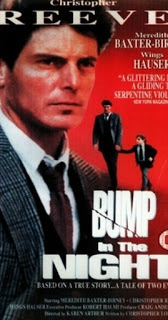 A number of smaller film roles kept him busy in the late 1980s, but none that earned him more than minor acclaim, and little financial reward. "I found most of the scripts they were sending me were poorly constructed heroic characters, and I felt the starring roles could easily be played by anyone with a strong physique. They didn't need me specifically, aside from my Superman persona." In an attempt to further distance himself from the hero role, Reeve accepted a shocking part, playing a vicious child molester in the TV movie, A Bump In The Night. He said of this performance: "I was sure that this one would finally drive the wedge between me and the Superman character. And critics thought I was great at it. Well, all except for TV Guide. The week that the movie aired, they ran this dreadful review saying: Who would ever believe that Superman could hurt a child? Purely sacrilegious and painful to watch. Can you imagine?"
A number of smaller film roles kept him busy in the late 1980s, but none that earned him more than minor acclaim, and little financial reward. "I found most of the scripts they were sending me were poorly constructed heroic characters, and I felt the starring roles could easily be played by anyone with a strong physique. They didn't need me specifically, aside from my Superman persona." In an attempt to further distance himself from the hero role, Reeve accepted a shocking part, playing a vicious child molester in the TV movie, A Bump In The Night. He said of this performance: "I was sure that this one would finally drive the wedge between me and the Superman character. And critics thought I was great at it. Well, all except for TV Guide. The week that the movie aired, they ran this dreadful review saying: Who would ever believe that Superman could hurt a child? Purely sacrilegious and painful to watch. Can you imagine?" There was an audible laugh in the room as he completed this story, though the look on his face seemed to indicate that he was seeking sympathy and not chuckles.
Toward the end of the presentation, Mr Reeve recounted an incident that had happened to him and his then girlfriend, Dana, in New York City. They had been picnicking in Central Park on a beautiful Sunday afternoon with the two children from Reeve's first marriage. "And then suddenly, out of nowhere, I hear this commotion in this distance. And here comes this man running in our direction at top speed, being chased by this older woman. As they got closer, I heard someone shout that the man had snatched her purse. Well, there was no way this woman was going to catch the guy, and here he was, running almost in a straight line right at me. My instinct kicked in and I jumped up, stood in the guy's path and did my best to tackle him to the grass. And sure enough, he did have the woman's
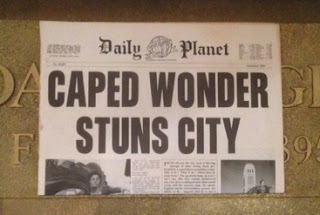 pocketbook over his shoulder. So I pinned him down and waited for the police to come and sort out the whole mess. Some people were clapping. A few might have recognized me. But honestly, I was just being a good Samaritan, nothing more. Anyway, the woman got her purse back and the guy got arrested. Oh, and someone just happened to snap my picture. And the next day, would you believe there I am on the front page of the New York Post, the Daily News and probably The Daily Planet, all with the same headline: SUPERMAN SAVES THE DAY. Even doing a good deed that anyone would have done, I somehow get linked right back to being the guy I tried so hard to get away from."
pocketbook over his shoulder. So I pinned him down and waited for the police to come and sort out the whole mess. Some people were clapping. A few might have recognized me. But honestly, I was just being a good Samaritan, nothing more. Anyway, the woman got her purse back and the guy got arrested. Oh, and someone just happened to snap my picture. And the next day, would you believe there I am on the front page of the New York Post, the Daily News and probably The Daily Planet, all with the same headline: SUPERMAN SAVES THE DAY. Even doing a good deed that anyone would have done, I somehow get linked right back to being the guy I tried so hard to get away from."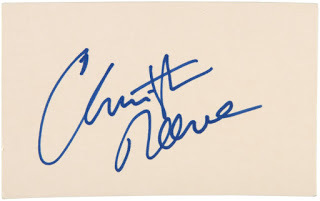 Christopher Reeve ended his lecture by taking a few questions from the audience. He then graciously offered to sign autographs for the students, given that the crowd was less than a hundred people. For a moment, I thought to myself that it would have been truly fantastic if I had known in advance that Mr. Reeve was going to be the surprise presenter that day. For sure I would have taken down that 1978 Scholastic Superman poster from my old childhood bedroom wall and... and after that speech he just gave about Superman and typecasting, there was absolutely no way I would have had the courage to ask him to sign it. In my imagination, he might have seen this as some form of career-blocking Kryptonite.
Christopher Reeve ended his lecture by taking a few questions from the audience. He then graciously offered to sign autographs for the students, given that the crowd was less than a hundred people. For a moment, I thought to myself that it would have been truly fantastic if I had known in advance that Mr. Reeve was going to be the surprise presenter that day. For sure I would have taken down that 1978 Scholastic Superman poster from my old childhood bedroom wall and... and after that speech he just gave about Superman and typecasting, there was absolutely no way I would have had the courage to ask him to sign it. In my imagination, he might have seen this as some form of career-blocking Kryptonite. Sadly, we all know how this story ends. On May 25, 1995, some four years after he visited my college, Christopher Reeve suffered a devastating spinal injury during an equestrian event. It left him paralyzed from the neck down for the rest of his life. But life didn't immediately end for Reeve with this tragic episode. A complicated surgery and months of rehabilitation enabled the actor the ability to speak again. And not long thereafter, he became an activist for Spinal Chord research, and later launched a foundation to raise funds in an effort to find a cure for paralysis. His movie career didn't end with this tragedy either. In 1996 he narrated an HBO documentary called, Without Pity. A year later he got to direct an HBO film called, In The Gloaming. And in 1998, Reeve starred in a remake of the Alfred
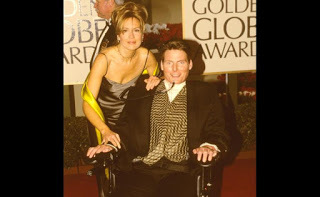 Hitchcock classic, Rear Window, for which he won a SAG award for Best Actor.
Hitchcock classic, Rear Window, for which he won a SAG award for Best Actor. Most ironically, the respect that had long eluded Christopher Reeve throughout his career as a healthy man due to the bias of his seemingly unbreakable Superman persona had finally arrived. And yet, no matter how much frustration Christopher Reeve expressed that day at the Olmstead theater about the perils of typecasting, undoubtedly he would have traded in all his post paralysis acclaim in an eyeblink to have continued a normal, healthy, awardless life, forever in the shadow of the man with the long red cape.
 Poet Of The Wrong Generation by Lonnie Ostrow is now available in paperback and eBook format. CLICK HERE TO ORDER YOUR COPY.
Poet Of The Wrong Generation by Lonnie Ostrow is now available in paperback and eBook format. CLICK HERE TO ORDER YOUR COPY.
Published on March 28, 2017 11:05
March 15, 2017
Summertime Nostalgia At The Twin Towers
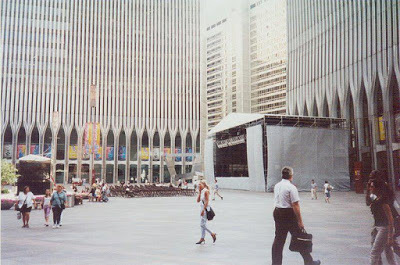 The Stage Between The Twin Towers at Austin J. Tobin PlazaWriting a novel which takes place in the early 1990s in New York City had me frequently thinking back on what life was like in that not-so-long ago era. It’s remarkable how much things have changed in a relatively short time period. Not just the skyline, the ballparks and the presence of Uber cabs on every street. For as sophisticated as the big city is, our existence was notably simpler back then. Email was in its infancy. Amazon was solely a desert without prime customers. Wi-Fi was not yet a concept (let alone a civic requirement). Security was far less of a presence. And you didn’t have sidewalks cluttered with distracted pedestrians checking their phones and texting their friends persistently. One of the simple joys that I recall both with fondness and a tinge of melancholy is a summertime ritual lost to time and terror. From 1987 – 2001, thousands of downtown workers would gather each week at Austin J. Tobin Plaza during their lunch hour for a series of free concerts. Tobin Plaza served as a park, performance venue, and crowd-funneling area in the open space directly between the Twin Towers of the World Trade Center. It was the ideal spot in lower Manhattan to entertain a large mid-day crowd. I’ll never forget the pure joy of escaping work for an hour on a warm day to grab a Frozefruit bar and join thousands of fellow New Yorkers for a free lunchtime concert by some of rock & roll’s legendary names. I first learned about the summer concert series from my late cousin, Michael Greenberg, who worked most of his adult life in lower Manhattan. It was June of 1995. I’d been employed a few months at a direct mail agency down on Hudson Street. Mike, who had been working just blocks from the Trade Center, often met me for lunch when the weather cooperated. We’d regularly wander the neighborhood, shopping for CDs at Tower Records, or duck inside the basement of the Century 21 department store.
The Stage Between The Twin Towers at Austin J. Tobin PlazaWriting a novel which takes place in the early 1990s in New York City had me frequently thinking back on what life was like in that not-so-long ago era. It’s remarkable how much things have changed in a relatively short time period. Not just the skyline, the ballparks and the presence of Uber cabs on every street. For as sophisticated as the big city is, our existence was notably simpler back then. Email was in its infancy. Amazon was solely a desert without prime customers. Wi-Fi was not yet a concept (let alone a civic requirement). Security was far less of a presence. And you didn’t have sidewalks cluttered with distracted pedestrians checking their phones and texting their friends persistently. One of the simple joys that I recall both with fondness and a tinge of melancholy is a summertime ritual lost to time and terror. From 1987 – 2001, thousands of downtown workers would gather each week at Austin J. Tobin Plaza during their lunch hour for a series of free concerts. Tobin Plaza served as a park, performance venue, and crowd-funneling area in the open space directly between the Twin Towers of the World Trade Center. It was the ideal spot in lower Manhattan to entertain a large mid-day crowd. I’ll never forget the pure joy of escaping work for an hour on a warm day to grab a Frozefruit bar and join thousands of fellow New Yorkers for a free lunchtime concert by some of rock & roll’s legendary names. I first learned about the summer concert series from my late cousin, Michael Greenberg, who worked most of his adult life in lower Manhattan. It was June of 1995. I’d been employed a few months at a direct mail agency down on Hudson Street. Mike, who had been working just blocks from the Trade Center, often met me for lunch when the weather cooperated. We’d regularly wander the neighborhood, shopping for CDs at Tower Records, or duck inside the basement of the Century 21 department store.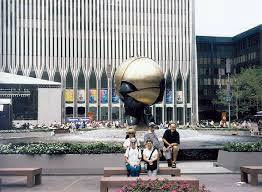
Like me, Mike was an aficionado of classic rock & roll. He and I attended many memorable concerts together. Through his broker “friends,” he’d often manage to score us tickets to some of the most in-demand shows including Paul McCartney in ‘89 at Giants Stadium and Fleetwood Mac with Squeeze at Jones Beach in 1990. But by the summer of ‘95, work had mostly overtaken play. And in my case, office life was exceptionally demanding. The job I had interviewed for was an assistant accounts manager, helping with the subscriber renewal campaigns for some popular magazines. I was hired at a low salary, trained by my supervisor for two weeks, then handed over the full responsibility of these clients when she departed ten days later for something more lucrative. My employer offered me none of the compensation, or perks of my predecessor. He even continued to refer to me as an “assistant” to justify the entry-level pay. It was delightful. The one perk that I was sure to make full usage of was my one-hour lunch break. Each day around 12:30, I’d forward my phone line to an answering machine (this was the pre-voicemail days) and step out to grab some fresh air and a sandwich. I’d even found a favorite pizza hangout down on Chambers Street, near Broadway. Personal calls at work were more difficult to manage in the era before cell-phones. Still, Mike and I did touch base regularly, usually late in the day to chat about last night’s ballgame, or a recent family gathering. Then came that Wednesday morning call in early July. “Hey Lonnie, come on down at the Trade Center at noon. Peter Noone and Herman’s Hermits are doing a free show.” We met up at the bustling curb just before Tobin Plaza. Mike knew we weren’t likely to get much closer for a popular attraction on a sunny afternoon. I’m not quite sure how we managed to find each other in the crowd without cell phones or GPS. Yet somehow, this is exactly what people did over the centuries that proceeded today’s technology. We each bought a snack from the Good Humor truck on the corner, then maneuvered about halfway through the crowd toward the stage area.
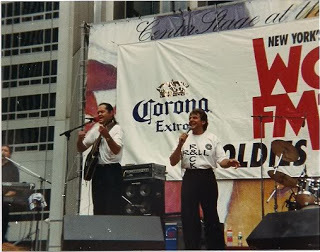
What I best remember about these summer concerts is the incredible backdrop that the towers provided. Each Wednesday, another musical star of the 1960s would play a free mini-concert on a wooden stage, framed by metal stanchion and draped with a huge rectangular banner for WCBS-FM, NY’s Oldies Station. At 12:15, the classic artist and his/her band would be introduced by a CBS-FM on-air personality, like Cousin Brucie or Norm N. Nite. The audio system was powerful enough for passerby’s to hear the music even a couple of blocks away. And the sight of the soaring steel and glass directly above the stage was dramatic, even breathtaking.
 Peter Noone’s free show was the first of many we would gather for that summer. The following week it was The Grass Roots, followed by Lesley Gore and later Felix Caveliere and the Rascals. Each week, the artist would perform a set of 6 – 8 of their best known tunes, sometimes interrupted by a lesser-known album track, or cover song. They would usually save their biggest hit for last, which resulted in a joyous sing-along. It’s My Party by Leslie Gore and Good Lovin’ by The Rascals had the crowd in whipped up in a frenzy. Midnight Confessionsby the Grass Roots saw hundreds of New Yorkers playing their best air guitar and keyboards. One week in mid August, we headed to the towers for a show by The Association. Even as a listener of “oldies radio,” I didn’t recall the band’s name being terribly familiar. An overcast morning kept early crowds to a minimum. I met Mike at the iconic bronze Sphere sculpture right in the center of the plaza. We were fortunate enough to get just steps away from the stage; the closest we had gotten for any of the shows. To our utter amazement, The Association were fabulous. For 45 minutes they played hit after hit (Along Came Mary, Cherish, Windy, Never My Love), as the crowd swelled in numbers and volume. So good were they that the group was urged on to play an unscheduled encore. It was the only time we witnessed something so spontaneous at one of these tightly scripted performances.
Peter Noone’s free show was the first of many we would gather for that summer. The following week it was The Grass Roots, followed by Lesley Gore and later Felix Caveliere and the Rascals. Each week, the artist would perform a set of 6 – 8 of their best known tunes, sometimes interrupted by a lesser-known album track, or cover song. They would usually save their biggest hit for last, which resulted in a joyous sing-along. It’s My Party by Leslie Gore and Good Lovin’ by The Rascals had the crowd in whipped up in a frenzy. Midnight Confessionsby the Grass Roots saw hundreds of New Yorkers playing their best air guitar and keyboards. One week in mid August, we headed to the towers for a show by The Association. Even as a listener of “oldies radio,” I didn’t recall the band’s name being terribly familiar. An overcast morning kept early crowds to a minimum. I met Mike at the iconic bronze Sphere sculpture right in the center of the plaza. We were fortunate enough to get just steps away from the stage; the closest we had gotten for any of the shows. To our utter amazement, The Association were fabulous. For 45 minutes they played hit after hit (Along Came Mary, Cherish, Windy, Never My Love), as the crowd swelled in numbers and volume. So good were they that the group was urged on to play an unscheduled encore. It was the only time we witnessed something so spontaneous at one of these tightly scripted performances.
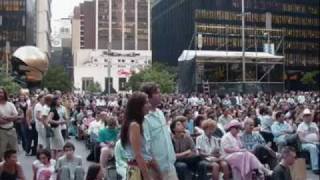
One convenient aspect of the summertime shows was that each artist actually played an identical set both at 12:15, and then again at 1:15. Latecomers who caught the tail end of the early performance could hang around and see the balance of the show after a 15 minute intermission. This format worked wonderfully for artists with a solid catalog of hits. Then there was Chubby Checker.
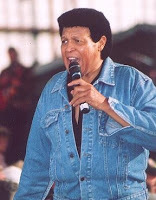 It was a beautiful August afternoon when Mr. Checker took the stage between the towers for his summertime spotlight. A strong crowd filled ¾ of the standing room on the plaza. And things got off to a roaring start with his biggest song, The Twist. Hundreds of New Yorkers were clapping and swiveling their hips. Next came his follow-up hit, Lets Twist Again, also fondly received. And then… the singer – apparently short on worthwhile material - elected to repeat the same two songs twice more. And this just to round out the opening set! A good portion of the early crowd left, looking perplexed during the first repeat. Later arrivals headed for the exit after the second duplication, leaving just a handful of spectators to take in the 1:15 show. The confused faces of the departing fans summarized the shortcoming of this sometimes limited format. Especially when the headliner was a legendary two-hit wonder.
It was a beautiful August afternoon when Mr. Checker took the stage between the towers for his summertime spotlight. A strong crowd filled ¾ of the standing room on the plaza. And things got off to a roaring start with his biggest song, The Twist. Hundreds of New Yorkers were clapping and swiveling their hips. Next came his follow-up hit, Lets Twist Again, also fondly received. And then… the singer – apparently short on worthwhile material - elected to repeat the same two songs twice more. And this just to round out the opening set! A good portion of the early crowd left, looking perplexed during the first repeat. Later arrivals headed for the exit after the second duplication, leaving just a handful of spectators to take in the 1:15 show. The confused faces of the departing fans summarized the shortcoming of this sometimes limited format. Especially when the headliner was a legendary two-hit wonder.
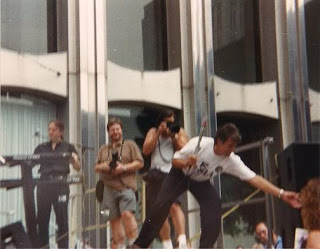 Davy Jones of The Monkees at the World Trade Center
Davy Jones of The Monkees at the World Trade CenterThe biggest crowd that summer at the Trade Center was for a concert by Mickey Dolenz and Davy Jones of The Monkees. Mike and I arrived at 12:10 to find the audience stretched all the way out onto West Street. Getting anywhere near the vicinity of the stage was a pipedream. But from our vantage point at the curb, we were at least able to hear the full performance and the roar of an adoring 6,000 fans. That didn’t even include the hundreds of workers watching through the glass inside the north tower. Monkey-mania was still very much alive in the summer of ’95.
Back in 1995, cell phones were not as commonplace, or as sophisticated as we now know them to be. As a result, few photos and even fewer videos exist of these magical summer freebies. One would have had to have owned a bulky camcorder and been close enough to the stage to pick up both the audio and video of the show. Only a handful of YouTube clips have surfaced.

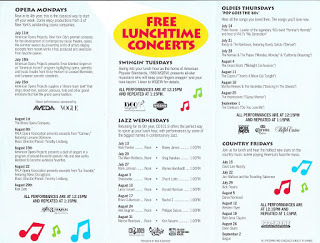 By the next summer, I had been firmly ensconced in a new job up on west 34th Street. Lunch-breaks were infrequent at best. And the Trade Center was now a good 25 minute commute. Mike still worked downtown and would often call me to meet him for the ’96 concert season. He mailed me a tri-fold pamphlet (which I still keep to this day) listing all the shows including Opera Mondays, Swinging Tuesdays, Jazz Wednesdays, and Country Fridays. But only Oldies Thursdays held any appeal to us. Just once was I able to escape work that summer. And that was to see a revamped lineup of The Mamas and the Papas featuring Papa John Phillips and a trio of non-original members. Uninspiring as the performance was, it was still great to bond with Mike and get away from my desk for a mini-summer vacation. Hard to believe that this would be my last time standing in the formidable shadow of the soaring Twin Towers.The summer concert series continued to draw large lunchtime audiences right up to the tragic morning of 9/11. An afternoon show had been scheduled there for that very day. One which would obviously never be played.
By the next summer, I had been firmly ensconced in a new job up on west 34th Street. Lunch-breaks were infrequent at best. And the Trade Center was now a good 25 minute commute. Mike still worked downtown and would often call me to meet him for the ’96 concert season. He mailed me a tri-fold pamphlet (which I still keep to this day) listing all the shows including Opera Mondays, Swinging Tuesdays, Jazz Wednesdays, and Country Fridays. But only Oldies Thursdays held any appeal to us. Just once was I able to escape work that summer. And that was to see a revamped lineup of The Mamas and the Papas featuring Papa John Phillips and a trio of non-original members. Uninspiring as the performance was, it was still great to bond with Mike and get away from my desk for a mini-summer vacation. Hard to believe that this would be my last time standing in the formidable shadow of the soaring Twin Towers.The summer concert series continued to draw large lunchtime audiences right up to the tragic morning of 9/11. An afternoon show had been scheduled there for that very day. One which would obviously never be played.When I gaze upon the skyline of lower Manhattan today, my heart aches for what is no longer there, rather than to admire the structure that stands in its place. So much of our youth, our past and our history was robbed from us on that fateful September Tuesday morning. That and the lives of nearly 3,000 New Yorkers, some of whom I likely rubbed shoulders with down on Austin J. Tobin Plaza on those warm summer afternoons.
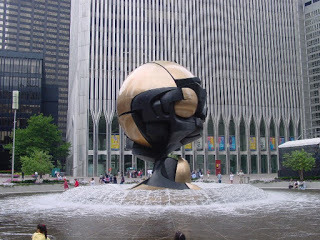 In spite of all of the unfathomable destruction from the 9/11 attacks, one singular landmark from Tobin Plaza remains mostly intact. The 25-foot tall bronze Sphere sculpture that served as a meeting-place for thirty years somehow emerged from the rubble of two collapsed skyscrapers with only some punctures, dents and scrapes. Today, it has been relocated to nearby Battery Park where it now stands next to an eternal flame as a memorial to everything and everyone we lost.When I tell my daughters about what life was like in the early 90s, I get a quite an array of surprised reactions and eye-rolls. They find it hard to believe that society once functioned without wireless tablets, Instagram and streaming video. “You mean you didn’t get a cell phone until you were 33? How’s that possible?” It’s a foreign concept that they will never quite wrap their mind around. But when I share stories of my summer afternoons with Cousin Mike, catching free concerts at the foot of the old Twin Towers, I detect a gleam of comprehension. An appreciation and disappointment of a time and place that they will never get to visit outside of their imagination.QuitePoet Of The Wrong Generation by Lonnie Ostrow is now available in paperback and eBook format. CLICK HERE to order your copy.
In spite of all of the unfathomable destruction from the 9/11 attacks, one singular landmark from Tobin Plaza remains mostly intact. The 25-foot tall bronze Sphere sculpture that served as a meeting-place for thirty years somehow emerged from the rubble of two collapsed skyscrapers with only some punctures, dents and scrapes. Today, it has been relocated to nearby Battery Park where it now stands next to an eternal flame as a memorial to everything and everyone we lost.When I tell my daughters about what life was like in the early 90s, I get a quite an array of surprised reactions and eye-rolls. They find it hard to believe that society once functioned without wireless tablets, Instagram and streaming video. “You mean you didn’t get a cell phone until you were 33? How’s that possible?” It’s a foreign concept that they will never quite wrap their mind around. But when I share stories of my summer afternoons with Cousin Mike, catching free concerts at the foot of the old Twin Towers, I detect a gleam of comprehension. An appreciation and disappointment of a time and place that they will never get to visit outside of their imagination.QuitePoet Of The Wrong Generation by Lonnie Ostrow is now available in paperback and eBook format. CLICK HERE to order your copy.
Published on March 15, 2017 07:18
March 1, 2017
The Heartbreak Behind Our Greatest Ballads

There is a moment in my novel, Poet Of The Wrong Generation,when our protagonist, Johnny Elias, experiences a stunning revelation. As a lifelong music fan, he always thought of ballads as a three minute escape into someone else’s melancholy. Never had he pondered the significance behind the poignant lyrics and melodies. But after a crushing betrayal by his long time love, the young poet is awakened to the reality of true inspiration via his own heartbreak. He finds the spark to compose a tear-jerking ballad entitled, We’ve Already Said Goodbye.” It’s a song that puts him on an unlikely trail to musical stardom, while unintentionally sending her down a path of desolation.
Throughout the history of pop music, there have been countless songs of pleading, anguish, longing and finality. Unrequited love and despair are almost certainly the greatest source behind the most heartfelt songs ever written. Here below is a unique look at some of the more heart-wrenching ballads and the stories behind the musical heartbreak.
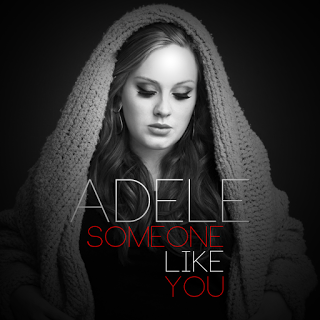 In 2011, British songstress, Adele topped the pop charts with her power-ballad, Someone Like You. It’s the torment of a spurned lover, wishing her ex well in his newfound relationship, but begging not to be forgotten. A bittersweet goodbye from someone who believes she has lost the love of her life. Although not confirmed by Adele, speculation is that this tune was penned about photographer, Alex Sturrock, who dated the singer on her 2009 US tour. Says Adele about the song: “We were so intense I thought we would get married. But that was something he never wanted... So when I found out he does want that with someone else, it was just the horrible-est feeling ever. But after I wrote it, I felt more at peace. It set me free.”
In 2011, British songstress, Adele topped the pop charts with her power-ballad, Someone Like You. It’s the torment of a spurned lover, wishing her ex well in his newfound relationship, but begging not to be forgotten. A bittersweet goodbye from someone who believes she has lost the love of her life. Although not confirmed by Adele, speculation is that this tune was penned about photographer, Alex Sturrock, who dated the singer on her 2009 US tour. Says Adele about the song: “We were so intense I thought we would get married. But that was something he never wanted... So when I found out he does want that with someone else, it was just the horrible-est feeling ever. But after I wrote it, I felt more at peace. It set me free.”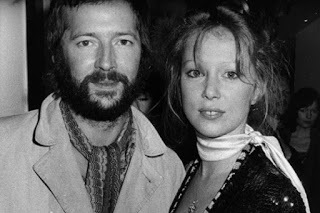 Eric Clapton and Patti Boyd Laylaby Eric Clapton is considered perhaps the ultimate ballad in classic rock, and one of intense desperation. It was penned by rock’s most revered guitarist in an attempt to win the affections of Patti Boyd, then the wife of his best friend, George Harrison of the Beatles. The song, composed in 1970, was the first grand gesture made by Clapton over a four-year courtship that eventually led to the breakup of the Harrison’s marriage. The ballad’s subject, Patti Boyd told Rolling Stone magazine: “Eric turned up one day when George was away. He said. ‘I've got something for you to hear,' and he put it on in a cassette machine and played it. And I said, 'Oh, gosh, this is unbelievable!' And he was just looking at me and saying, 'This is for you, I've written it for you.'" Clapton would go on to marry Boyd in 1979. They would divorce in 1988, but the song (released in 1972 by Clapton’s band, Derek and the Dominos) remains a timeless example of musical pleading, epitomized by the second verse:
Eric Clapton and Patti Boyd Laylaby Eric Clapton is considered perhaps the ultimate ballad in classic rock, and one of intense desperation. It was penned by rock’s most revered guitarist in an attempt to win the affections of Patti Boyd, then the wife of his best friend, George Harrison of the Beatles. The song, composed in 1970, was the first grand gesture made by Clapton over a four-year courtship that eventually led to the breakup of the Harrison’s marriage. The ballad’s subject, Patti Boyd told Rolling Stone magazine: “Eric turned up one day when George was away. He said. ‘I've got something for you to hear,' and he put it on in a cassette machine and played it. And I said, 'Oh, gosh, this is unbelievable!' And he was just looking at me and saying, 'This is for you, I've written it for you.'" Clapton would go on to marry Boyd in 1979. They would divorce in 1988, but the song (released in 1972 by Clapton’s band, Derek and the Dominos) remains a timeless example of musical pleading, epitomized by the second verse: I tried to give you consolation. When your old man had let you down.
Like a fool, I fell in love with you. Turned my whole world upside down.
Layla was not the only rock classic in which Boyd inspired. She was earlier the subject of George Harrison’s classic Something on the Beatles Abbey Road album. Later, she was the “beautiful lady” in Eric Clapton’s standard, Wonderful Tonight. Patti Boyd is almost certainly rock and roll’s greatest muse.
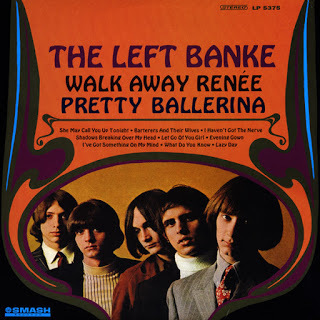 Walk Away Renee by the Left Banke just might be the quintessential pop ballad of the 1960s. Rolling Stonemagazine ranks it as one of the top 200 songs of all-time. It is a recording so unique (featuring strings, harpsichord and a flute) that it helped to inspire a musical sub-category called “Baroque Rock.” And yet, as impassioned as the song comes off to the listener, it is not a traditional break-up song, but rather one written to prevent one of a different kind. In 1966, the band’s keyboardist and primary songwriter, Michael Brown, found himself falling hard for Renée Fladen, a young beauty who just happened to be the girlfriend of the group’s bassist, Tom Finn. A month after meeting his muse, Brown’s infatuation grew, prompting him to pen the now legendary, anguished song. In the chorus he begs her to “just walk away,” rather than allow her to come between him and his band-mate. Brown said of his unrequited feelings: "I was just sort of mythologically in love, if you know what I mean, without having evidence in fact or in deed. But I was as close as anybody could be to the real thing." Renée herself was said to be on hand in the studio during the recording of the song, and her presence left the songwriter frazzled. In an interview with ClassicBands.com, Brown stated: "My hands were shaking when I tried to play (the harpsichord), because she was right there in the control room. There was no way I could do it with her around, so I came back and did it later." Walk Away Renee went on to reach # 5 on the pop charts, and was later, famously covered by The Four Tops and Linda Ronstadt. The original is 2:48 of tormented pop music perfection.
Walk Away Renee by the Left Banke just might be the quintessential pop ballad of the 1960s. Rolling Stonemagazine ranks it as one of the top 200 songs of all-time. It is a recording so unique (featuring strings, harpsichord and a flute) that it helped to inspire a musical sub-category called “Baroque Rock.” And yet, as impassioned as the song comes off to the listener, it is not a traditional break-up song, but rather one written to prevent one of a different kind. In 1966, the band’s keyboardist and primary songwriter, Michael Brown, found himself falling hard for Renée Fladen, a young beauty who just happened to be the girlfriend of the group’s bassist, Tom Finn. A month after meeting his muse, Brown’s infatuation grew, prompting him to pen the now legendary, anguished song. In the chorus he begs her to “just walk away,” rather than allow her to come between him and his band-mate. Brown said of his unrequited feelings: "I was just sort of mythologically in love, if you know what I mean, without having evidence in fact or in deed. But I was as close as anybody could be to the real thing." Renée herself was said to be on hand in the studio during the recording of the song, and her presence left the songwriter frazzled. In an interview with ClassicBands.com, Brown stated: "My hands were shaking when I tried to play (the harpsichord), because she was right there in the control room. There was no way I could do it with her around, so I came back and did it later." Walk Away Renee went on to reach # 5 on the pop charts, and was later, famously covered by The Four Tops and Linda Ronstadt. The original is 2:48 of tormented pop music perfection. Unreciprocated affection is the spark that ignited the 2007 chart-topper, Hey There Delilah by Plain White T’s. Written by lead singer, Tom Higgenson, the acoustic ballad is about a long distance couple who talk about their future plans of her finishing school and him becoming a famous guitar player. It was inspired by track and field athlete, Delilah DiCrescnzo, an Olympic hopeful when she met the songwriter in New York. In an interview with USA Today, Higgenson said: "I thought she was the most beautiful girl I’d ever seen. I told her, 'I have a song about you already.' Obviously, there was no song. But I thought it was smooth." Delilah was, in fact, involved in a committed relationship. She made it clear that she was off limits. Still, the creative seed had been planted. The band’s guitarist Dave Tirio explained: "I remember when we met Delilah back in the day. Tom was just kind of flirting with her and he was talking about writing a song about her and she responded by goofing around and saying ‘oh where is my song? I want to hear this thing.’ He got about four lines in and just writing about how she’d gone off to school and how much he missed her. Then he kinda spun that into what would you want to say to any girl in your life that you were totally head over heels for; all the things you would want to cram into one little conversation." The ballad slowly climbed the pop charts, eventually hitting # 1, more than a year after its release. DiCrescnzo, the song’s muse told ESPN: “It’s catchy, melodic. It’s very romantic. It means something to everybody — especially for anybody who ever yearned for someone.”It was nominated for a pair of Grammy awards including Song Of The Year. Delilah attended the ceremony with Tom Higgenson
Unreciprocated affection is the spark that ignited the 2007 chart-topper, Hey There Delilah by Plain White T’s. Written by lead singer, Tom Higgenson, the acoustic ballad is about a long distance couple who talk about their future plans of her finishing school and him becoming a famous guitar player. It was inspired by track and field athlete, Delilah DiCrescnzo, an Olympic hopeful when she met the songwriter in New York. In an interview with USA Today, Higgenson said: "I thought she was the most beautiful girl I’d ever seen. I told her, 'I have a song about you already.' Obviously, there was no song. But I thought it was smooth." Delilah was, in fact, involved in a committed relationship. She made it clear that she was off limits. Still, the creative seed had been planted. The band’s guitarist Dave Tirio explained: "I remember when we met Delilah back in the day. Tom was just kind of flirting with her and he was talking about writing a song about her and she responded by goofing around and saying ‘oh where is my song? I want to hear this thing.’ He got about four lines in and just writing about how she’d gone off to school and how much he missed her. Then he kinda spun that into what would you want to say to any girl in your life that you were totally head over heels for; all the things you would want to cram into one little conversation." The ballad slowly climbed the pop charts, eventually hitting # 1, more than a year after its release. DiCrescnzo, the song’s muse told ESPN: “It’s catchy, melodic. It’s very romantic. It means something to everybody — especially for anybody who ever yearned for someone.”It was nominated for a pair of Grammy awards including Song Of The Year. Delilah attended the ceremony with Tom Higgenson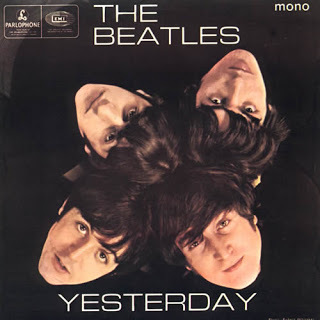 Yesterday by the Beatles is the most covered song in music history. Paul McCartney’s 1965 opus has been recorded by some 3,000 artists ranging from Frank Sinatra to Elvis Presley to Placido Domingo. McCartney has often recounted that he composed the timeless melody in his sleep one night when living in the London home of his longtime girlfriend, Jane Asher. However, the lyrics are not about Asher, but rather about another great love which he lost many years earlier. Paul’s mother, Mary McCartney was a nurse and midwife; the primary earner in their household. She was on call for deliveries at all hours, and Paul has periodically expressed his memories of seeing her biking off to the hospital because the family did not own a car. Mary died from complications of breast cancer surgery in 1956. She was only 47. Paul was just 14. When informed of his mother’s death, young Paul’s initial reaction was cold and thoughtless. “What are we going to do without her money?” he asked his grieving father. These words, he says, still haunt him. In Yesterday he sings: “I said something wrong, now I long for yesterday,” a line of regret, wishing he could take back his youthful insensitivity. In 2013, Paul told Mojo magazine: “With 'Yesterday', singing it now, I think without realising it I was singing about my mum, because I think now, ‘Why she had to go, I don’t know, she wouldn’t say, I said something wrong…’ I think the psychiatrist would have a field day with that one.”
Yesterday by the Beatles is the most covered song in music history. Paul McCartney’s 1965 opus has been recorded by some 3,000 artists ranging from Frank Sinatra to Elvis Presley to Placido Domingo. McCartney has often recounted that he composed the timeless melody in his sleep one night when living in the London home of his longtime girlfriend, Jane Asher. However, the lyrics are not about Asher, but rather about another great love which he lost many years earlier. Paul’s mother, Mary McCartney was a nurse and midwife; the primary earner in their household. She was on call for deliveries at all hours, and Paul has periodically expressed his memories of seeing her biking off to the hospital because the family did not own a car. Mary died from complications of breast cancer surgery in 1956. She was only 47. Paul was just 14. When informed of his mother’s death, young Paul’s initial reaction was cold and thoughtless. “What are we going to do without her money?” he asked his grieving father. These words, he says, still haunt him. In Yesterday he sings: “I said something wrong, now I long for yesterday,” a line of regret, wishing he could take back his youthful insensitivity. In 2013, Paul told Mojo magazine: “With 'Yesterday', singing it now, I think without realising it I was singing about my mum, because I think now, ‘Why she had to go, I don’t know, she wouldn’t say, I said something wrong…’ I think the psychiatrist would have a field day with that one.”I Will Always Love You may best be known for the
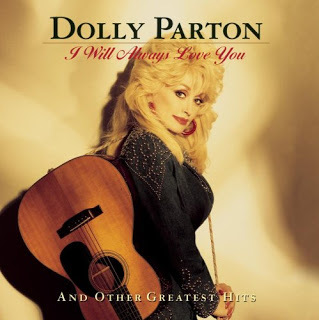 chart-topping rendition by Whitney Houston in 1992 for the film The Bodyguard. But this bittersweet song was actually composed by country legend, Dolly Parton in 1973. Like many great ballads, this one spotlights a parting of the ways. However, in this instance, it is not the separation of lovers that she sings of, but rather the dissolution of a professional partnership. Country music author Curtis W. Ellison stated that the song "speaks about the breakup of a relationship between a man and a woman that does not descend into unremitting domestic turmoil, but instead envisions parting with respect – because of the initiative of the woman." In 1967, country star Porter Wagoner gave an unknown Dolly Parton her big break by hiring her to appear on his weekly TV show. Over seven years, Dolly went from being Porter’s musical apprentice to an escalating star. In 1973, she elected to exit the show and forge a solo career. On her final episode, Dolly debuted her new song inspired by their platonic breakup and her mixed feelings at leaving her mentor behind. She told the CMT network: “It’s saying, ‘Just because I’m going don’t mean I won’t love you. I appreciate you, and I hope you do great, and I appreciate everything you’ve done, but I’m out of here. And I took it in the next morning. I said, ‘Sit down, Porter. I’ve written this song, and I want you to hear it.’ So I did sing it. And he was crying. He said, ‘That’s the prettiest song I ever heard. And you can go, providing I get to produce that record.’ And he did, and the rest is history.”
chart-topping rendition by Whitney Houston in 1992 for the film The Bodyguard. But this bittersweet song was actually composed by country legend, Dolly Parton in 1973. Like many great ballads, this one spotlights a parting of the ways. However, in this instance, it is not the separation of lovers that she sings of, but rather the dissolution of a professional partnership. Country music author Curtis W. Ellison stated that the song "speaks about the breakup of a relationship between a man and a woman that does not descend into unremitting domestic turmoil, but instead envisions parting with respect – because of the initiative of the woman." In 1967, country star Porter Wagoner gave an unknown Dolly Parton her big break by hiring her to appear on his weekly TV show. Over seven years, Dolly went from being Porter’s musical apprentice to an escalating star. In 1973, she elected to exit the show and forge a solo career. On her final episode, Dolly debuted her new song inspired by their platonic breakup and her mixed feelings at leaving her mentor behind. She told the CMT network: “It’s saying, ‘Just because I’m going don’t mean I won’t love you. I appreciate you, and I hope you do great, and I appreciate everything you’ve done, but I’m out of here. And I took it in the next morning. I said, ‘Sit down, Porter. I’ve written this song, and I want you to hear it.’ So I did sing it. And he was crying. He said, ‘That’s the prettiest song I ever heard. And you can go, providing I get to produce that record.’ And he did, and the rest is history.”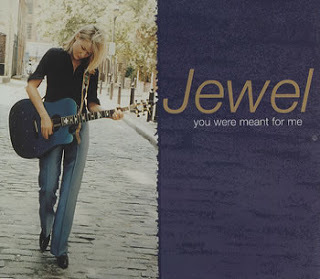 Sometimes, even the mundane, everyday tasks can provide good fodder for a song of heartbreak. In 1995, Alaskan folk singer, Jewel, burst on the music scene with the raw and sentimental, You Were Meant For Me. This song describes those early days after a breakup, when she attempts to go about her daily routine but cannot shake the doldrums of being alone. As Jewel makes breakfast, showers and dresses for the day, all she can think about is how empty everything is without the man she loves. The tune is haunting, yet peaceful, sung with great vulnerability to the accompaniment of an acoustic guitar. Some of the most poignant lyrics are found in the song’s bridge:
Sometimes, even the mundane, everyday tasks can provide good fodder for a song of heartbreak. In 1995, Alaskan folk singer, Jewel, burst on the music scene with the raw and sentimental, You Were Meant For Me. This song describes those early days after a breakup, when she attempts to go about her daily routine but cannot shake the doldrums of being alone. As Jewel makes breakfast, showers and dresses for the day, all she can think about is how empty everything is without the man she loves. The tune is haunting, yet peaceful, sung with great vulnerability to the accompaniment of an acoustic guitar. Some of the most poignant lyrics are found in the song’s bridge: I go about my business, I'm doing fine
Besides what would I say if I had you on the line?
Same old story, not much to say
Hearts are broken, everyday.
“I was probably 19 when I wrote You Were Meant For Me,” says Jewel to Songwriters Universe. “It was this naïve, sweet longing, and then you grow up and you actually fall in love, and you realize how hard it is and how much work it is. You start to realize that the difference between lust and love is that you actually stick around when it’s hard when you’re in love. You find that you can’t leave and the hard things seem worthwhile, and you’re actually able to find poetry in the daily struggle of building a relationship.” The song hit # 2 on the Billboard singles chart and was the most played radio song of 1996.
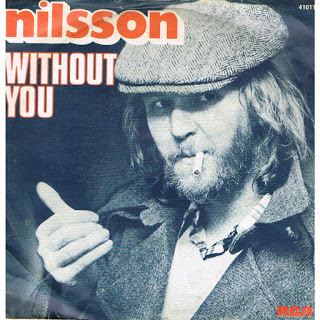 Of all the heartfelt ballads in pop music history, perhaps the most gut-wrenching of all is Without You, most famously sung by Harry Nilsson in 1971. It is the story of two lovers who have gone separate ways, and the singer proclaims that he “can’t live if living is without you.” Paul McCartney described it to VH-1 as "the killer song of all time." The verses were written by Pete Ham of the band Badfinger (inspired by his girlfriend at the time, Beverly Tucker). The chorus was composed by his band-mate, Tom Evans (about his future wife, Marianne). The two separate compositions, referring to real events in the songwriters' lives flowed together to create the song. Pete Ham had written a tune originally titled: If It's Love, but the chorus was lackluster. The second verse was written first.
Of all the heartfelt ballads in pop music history, perhaps the most gut-wrenching of all is Without You, most famously sung by Harry Nilsson in 1971. It is the story of two lovers who have gone separate ways, and the singer proclaims that he “can’t live if living is without you.” Paul McCartney described it to VH-1 as "the killer song of all time." The verses were written by Pete Ham of the band Badfinger (inspired by his girlfriend at the time, Beverly Tucker). The chorus was composed by his band-mate, Tom Evans (about his future wife, Marianne). The two separate compositions, referring to real events in the songwriters' lives flowed together to create the song. Pete Ham had written a tune originally titled: If It's Love, but the chorus was lackluster. The second verse was written first."Well I can't forget tomorrow, when I think of all my sorrow, I had you there but then I let you go, and now it's only fair that I should let you know... if it's love."
Events in Evans' life would lead to the completion of the track. While on tour he had met the woman who would become his future wife, Marianne. One evening she ran off after an argument. He wrote a song called 'I Can't Live'. Its chorus: "I can't live, if living is without you, I can't live, I can't give any more.” And so the merging of the two songs created something exceptional. Ham's verses, warm, sweet and sentimental. Evans' chorus, intense, dramatic and heartbreaking. Both Ham and Evans said they did not consider the song to have much potential at the time Badfinger recorded it. Though the band would score several top-40 hits, this would not be one of them.
Harry Nilsson was best known in 1970 for his hit Everybody's Talkin,' from the movie, Midnight Cowboy. He heard Badfinger's recording of "Without You" at a party, and decided to cover it for his album Nilsson Schmilsson in 1971. The song was released as a single in October 1971, and it stayed at number 1 on the U.S. pop chart for four weeks. It features one of the rangiest male vocal performances ever recorded. His injection of all-out passion turned a good song into a great one. Mariah Carey's 1994 cover version is faithfully based on Harry Nilsson's emotional recording rather than the Badfinger restrained original. It reached number 3 on the Billboard Hot 100. Without You remains Carey's biggest hit across Europe. It became her first UK number 1 single. The ballad is a perfect storm of heartache and hopelessness, piano and violins blended together in a recipe of delicious sorrow.
Gut-wrenching ballads have been written and performed through the decades by a wide array of tormented, talented artists. Whether folksy, piano driven, hard rocking, or tinged with country twang, all of these truly-inspired classics find a way to transport us to a place where melancholy never fails to tug hard on our heartstrings.
Poet Of The Wrong Generation by Lonnie Ostrow is now available in paperback and eBook format. CLICK HERE TO ORDER YOUR COPY.

Published on March 01, 2017 07:53
February 15, 2017
The Central Park Concert: An Illustrious History

New York City is forever a big-event kind of town. It has hosted 216 parades down the Canyon Of Heroes, 40 Macy’s July Fourth Fireworks spectaculars, 89 Thanksgiving Parades, 5 Papal visits, 44 NY Marathons, 96 US Open Tennis Tournaments, 115 Times Square New Years Eve celebrations, 6 Presidential party conventions and 2 World Fairs. But in a city known for high-profile pageantry, there is nothing larger, or more spectacular than a free concert in Central Park.
When one thinks of the spectacle that is a Central Park concert, the first thing that probably comes to mind is the mammoth, unprecedented crush of cheering humanity. A free rock show in the Park on a warm evening has routinely drawn in the range of half a million spectators. Music fans from far and wide turn out just to say that they were a part of something extraordinary. Its one of those rare extravaganzas never to be missed. Or at least it once was.
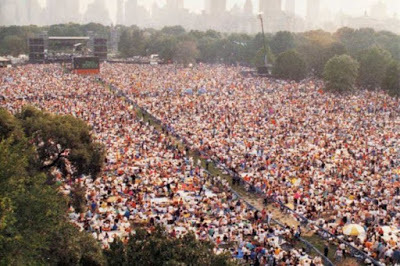 Massive Crowds For Paul Simon's 1991 Central Park Concert
Massive Crowds For Paul Simon's 1991 Central Park ConcertThe other main ingredient is of course is the headliner. Only an artist of legendary proportions has the ability to attract the masses on New York City’s largest (if most improbable) concert venue. A flimsy crowd on such a huge chunk of real estate would prove an utter embarrassment to the performer… not to mention a colossal waste of resources by the city. Those rarefied entertainers who have played (and packed) the park include such icons as The Beach Boys, Garth Brooks, Luciano Pavarotti, Diana Ross, Simon & Garfunkel and Bon Jovi.
In my novel, Poet Of The Wrong Generation, the story both opens and closes at a pair of concerts on the Great Lawn in Central Park: One real (Paul Simon in 1991) and one fictional. These disparate bookend events express reverence toward the remarkable connection between spectator and performer at such over-sized, dreamlike musical celebrations. Civic gatherings that stretch back more than a century on this hallowed oasis, smack in the center of mid-town Manhattan.
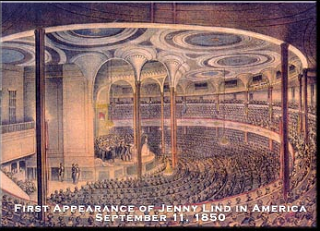 The origins of live music in a New York City park may surprise you. If someone asked: “Who was the first performer to headline a park concert in Manhattan?” you might be inclined to say Barbra Streisand in 1967. And in fact, Ms. Streisand was the first pop music headliner to play for the masses in Central Park during the past half-century. However, the park music spectacle in NYC dates all the way back to 1850. That’s when legendary circus promoter P.T. Barnum staged an epic concert at Castle Garden (now Castle Clinton) in Battery Park featuring Jenny Lind, the “Swedish Nightingale” and the biggest opera star of her day. Over 40,000 New Yorkers lined Canal Street to greet her arrival by boat from Sweden due to massive hype, though only 5,500 were able to view her American debut concert due to seating capacity.
The origins of live music in a New York City park may surprise you. If someone asked: “Who was the first performer to headline a park concert in Manhattan?” you might be inclined to say Barbra Streisand in 1967. And in fact, Ms. Streisand was the first pop music headliner to play for the masses in Central Park during the past half-century. However, the park music spectacle in NYC dates all the way back to 1850. That’s when legendary circus promoter P.T. Barnum staged an epic concert at Castle Garden (now Castle Clinton) in Battery Park featuring Jenny Lind, the “Swedish Nightingale” and the biggest opera star of her day. Over 40,000 New Yorkers lined Canal Street to greet her arrival by boat from Sweden due to massive hype, though only 5,500 were able to view her American debut concert due to seating capacity.The first Central Park concerts were held in the spring and summer of 1859. They were nothing like the mega-productions that we think of today. No stage. No lights. No amplification. Just musicians and instruments. These free Saturday afternoon shows were given by military bands. They took place in an area known as “The Ramble” (near the lake between 73rd and 78th Streets). The performances were attended by up to 600 locals. Gradually, the concerts moved to the area known as “The Mall,” a larger open space on the East-side of the park from 66th to 77th Streets. A cast-iron bandstand was built on the north end of this terrain. Up to 5,000 could now enjoy an afternoon of live classical, or opera music.
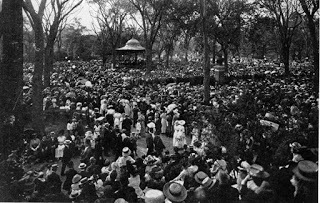 In 1910, the New York City Parks Department had built a band shell up at the north end of McGowan’s Pass (Fifth Avenue and 102nd’ Street), where they staged musical performances six days a week in the summer. Municipal appreciation of “good music” was seen as an essential cultural building block by the local government. In other words, music brought people together.
In 1910, the New York City Parks Department had built a band shell up at the north end of McGowan’s Pass (Fifth Avenue and 102nd’ Street), where they staged musical performances six days a week in the summer. Municipal appreciation of “good music” was seen as an essential cultural building block by the local government. In other words, music brought people together.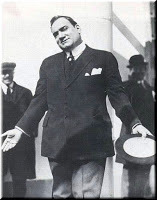 Opera Legend Enrico Caruso
Opera Legend Enrico Caruso So who was the first major headliner to perform a free concert in Central Park? That would be Italian opera star, Enrico Caruso in 1918. More than 50,000 New Yorkers turned out to hear the singer perform an English and French rendition of the popular, patriotic standard, Over There. At the time it was considered the largest single gathering in the park.
During the ensuing decades, big-band shows became a popular park attraction. Edwin Franko Goldman's Concert Band began performing on the Mall in 1923 at the newly built Naumberg Bandshell. From 1934 until the early ‘60s, the finals of a citywide Barbershop Quartet contest were held with great fanfare on the Mall area. And in 1968, some 8,000 girl scouts assembled in Sheep Meadow to sing Happy Birthday to composer Irving Berlin on the occasion of his 80th birthday.
Performances of classical symphonies by the NY Philharmonic have been a summertime staple going back to 1965. But the idea for these popular gigs actually came from the city of Milwaukee. In 1964, the Schlitz Brewing Company sponsored a free concert in an outdoor park, flying in the NY Philharmonic to Wisconsin. The show drew more than 30,000 music fans, prompting NYC to stage a similar event the following summer. The initial performance on Sheep Meadow in Central Park drew more than double the Milwaukee crowd. A new tradition was born.
In 1966, famed conductor, Leonard Bernstein led the NY Philharmonic in a performance of Beethoven’s Symphony # 3 for a then
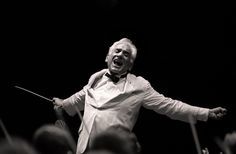 Leonard Bernstein in Central Park - 1966record crowd of 75,000. A milestone shattered in 1973 when he conducted an all-Tchaikovsky program in front of a mind-blowing 110,000. Now we’re talkin’ serious numbers. Jazz and Rock music soon followed the success of the classical shows in the park. It began with modest success under the banner of the Rheingold Music Festival at Wollman Rink in 1966. The outdoor ice-skating wintertime attraction was transformed into an unlikely concert venue in the summer months. These were ticketed events with the price starting at just $1. The venue held a capacity for a modest 6,000 attendees, but still managed to draw some of the biggest names in pop music history including Jimi Hendrix, Nina Simone, Benny Goodman, Ray Charles, BB King, The Who, Chuck Berry, Miles Davis, Led Zeppelin, Neil Young, The Supremes, The Everly Brothers, Fleetwood Mac, The Doors, Aerosmith and Ella Fitzgerald.
Leonard Bernstein in Central Park - 1966record crowd of 75,000. A milestone shattered in 1973 when he conducted an all-Tchaikovsky program in front of a mind-blowing 110,000. Now we’re talkin’ serious numbers. Jazz and Rock music soon followed the success of the classical shows in the park. It began with modest success under the banner of the Rheingold Music Festival at Wollman Rink in 1966. The outdoor ice-skating wintertime attraction was transformed into an unlikely concert venue in the summer months. These were ticketed events with the price starting at just $1. The venue held a capacity for a modest 6,000 attendees, but still managed to draw some of the biggest names in pop music history including Jimi Hendrix, Nina Simone, Benny Goodman, Ray Charles, BB King, The Who, Chuck Berry, Miles Davis, Led Zeppelin, Neil Young, The Supremes, The Everly Brothers, Fleetwood Mac, The Doors, Aerosmith and Ella Fitzgerald.The most notable of the Wollman Rink concerts occurred in 1975. Now under the sponsorship of Schaffer Beer, the opening show of the ‘75 season featured Bob Marley and the Wailers. More than 15,000 fans jammed into the bandstand near the Central Park Mall, while thousands more sprawled out on the grass and under the trees. It was an epic turnout for an artist in his prime, proving that the appetite for large-scale pop music shows was rapidly increasing.
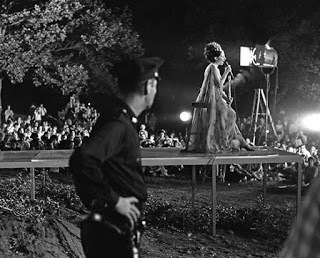 Barbra Streisand performs in Central Park - 1967
Barbra Streisand performs in Central Park - 1967So what was the first major free pop music extravaganza? In June of 1967, A Happening In Central Park was a CBS TV special, a live album, and oh yes, a mega concert given by Barbara Streisand in her vocal prime. More than 130,000 turned out on Sheep Meadow for this pioneer spectacle, initiated by then Mayor, John Lindsay and his “Urban Revival” campaign. Streisand had taken a break from filming the movie Funny Girl to fly back to NY and give this two hour performance. Many who arrived early were treated to a mid-afternoon sound-check rehearsal by the headliner herself. The epic show was a high-point in Streisand’s career, and opened the door to what has become the ultimate concert showcase for music legends.
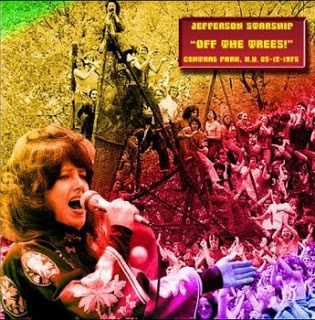
The next big name to get their Central Park close-up were stars in their time, though not nearly as iconic as the other park headliners. Jefferson Starship (previously Jefferson Airplane) performed at Sheep Meadow on May 12th, 1975 to an estimated 100,000 rock music fans. The 95 minute show featured both classic songs from the band’s early days and tracks from their album Red Octopus, which had not yet been released. Of note from this show was that many trees in the park were damaged that day from fans climbing up to get a better view.
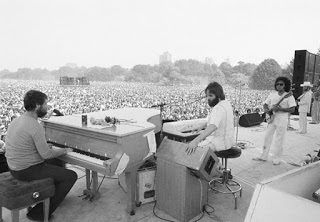
On September 1, 1977, The Beach Boys brought the California sound and surf to Central Park to celebrate a pair of milestones: 1) The band’s 15th anniversary, and 2) Surpassing the mark of 30 million records sold. More than 150,000 jammed the park for this summertime spectacular – the first ever on the Great Lawn. The band’s full original lineup performed 26 songs over 80-minutes in the late afternoon sunshine. Some fans climbed up trees and baseball backstops to catch a glimpse of the hit-fueled show.
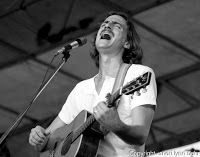
In 1979 it was James Taylor who would get to play the next and final concert on Sheep Meadow. The popular folk rocker’s show was actually intended to be a benefit to help restore Sheep Meadow to its former glory after falling into a state of disrepair. An estimated 250,000 packed the park to enjoy the 90-minute performance, which included several songs off Taylor’s new album, Flag. The crowd was deemed a new Central Park attendance record, and sponsorship money allowed Sheep Meadow to be re-sodded the following spring.
One year later, it was Elton John who re initiated the Great Lawn with a free mega concert. An estimated 400,000 (another new attendance record) turned out to sing along with the Rocket Man
Few music fans thought they would see a reunion of Paul Simon and Art Garfunkel after their bitter breakup in 1970. But the celebrated electric folk duo from Queens, NY chose to set aside hostilities for a blockbuster show on the Great Lawn in September of 1981. The free concert was billed as a benefit to help restore the park. An estimated 500,000 were said to have attended despite cool temperatures and rain, which only let up at showtime. Millions more got to watch it on HBO, and hear the popular live album which provided the revenue for the City. Twenty-one songs were played over 90 harmonious minutes. And the record-setting crowd relished every moment.
The No Nukes rally on June 12, 1982 can’t be classified as solely a concert event. Nor can the attendance estimates of 750,000 to over one million be trusted at face value. But this largest ever political demonstration (which began with a march down 5th Avenue) did culminate with a series of superstar musical performances from a stage on the Great Lawn. Bruce Springsteen, Jackson Browne, Joan Baez, Linda Ronstadt and Gary U.S. Bonds headlined this musical and political protest against the threat of nuclear weapons.
All the major concert events held in Central Park through 1982 were blessed with mostly ideal weather and model behavior by the throng of spectators. Then came Diana Ross and her Great Lawn concert. An estimated 800,000 (another park record) turned out on the evening of July 21, 1983 to hear the “Supreme Lady” perform her vast catalog of hits. The show was also to be a Showtime TV special and a benefit to build a new park playground. But only two songs into the set, torrential rain began falling on the crowd and stage. Ms. Ross defiantly declared that the show would go on. And for 35 minutes she sung in a downpour, fighting wind gusts and sheets of drenching rain. Then came the lightning. A decision was made to curtail the show and reattempt it the very next night (at enormous expense to the city). The weather was a non-issue for the 2nd night’s performance. An impressive 350,000 came back to enjoy the music. But the evening was marred by a string of incidents perpetrated by rampaging teenage gangs, who harassed, attacked and robbed concert-goers. In all, 83 people were arrested, 37 of them for assault or robbery. These negative incidents and resulting publicity convinced the City to put a halt on future concerts for nearly a decade.
From 1983 – 1991, only the NY Philharmonic was given clearance to perform in Central Park. The mild-mannered classical music fans were obviously no threat to rowdy behavior, or a need for a mass police presence. It wasn’t until 1991 that the NYC Parks Department relented on their ban of pop music shows.
On August 15th of ‘91, Paul Simon became the first and only musician to get an encore performance on New York’s biggest stage. Perhaps given the mostly middle-age demographic of Simon’s still-strong fan base, the city deemed him to be a safe bet for a large, well-behaved crowd. And what a crowd they got! The original estimate for this show was announced at 750,000 (later modified to 600,000). Simon was riding the wave of popularity with a pair of highly successful solo albums. His show did not feature an appearance by his estranged partner, Art Garfunkel, but it did include a healthy dose of Simon & Garfunkel songs, along with many of his solo hits. The live broadcast on HBO showcased the most idyllic New York City musical celebration ever held. The only downside was the damage to the lawn itself, which would have to be repaired at the expense of Simon’s record company.
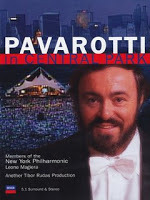
In June of 1993, legendary tenor, Lucinao Pavoratti, became the first opera star to headline Central Park in 75 years. He had been slated to perform there back in 1991, but that show was rained out. His ’93 performance on the Great Lawn was backed by the NY Philharmonic orchestra and drew an estimated 500,000 spectators. Millions more watched at home on the PBS cable network.
So what has been the largest attended event in Central Park’s history? That took place on the evening of August 7, 1997. Country music superstar, Garth Brooks performed to crowds that estimate anywhere from 750,000 to 980,000. This show was the first to be held on the area called North Meadow. It featured a spectacular 360 foot circular stage to provide the audience with an optimal view. Special guests included American Pie singer, Don McClean and NY’s hometown favorite, Billy Joel. Some 14.6 million tuned into the live HBO broadcast. Brooks performed 19 songs during the 95 minute show, which was nicknamed “Garthstock” by his rabid fans. Sadly, it would also be the last of the truly mega-shows in New York City.
The terrorist attacks of September 11, 2001 forever changed our way of life in America. Heightened security at all large gatherings prompted the implementation of strict new measures. Metal detectors and security wands at the entrance of entertainment events have become commonplace. And knowing that the threat of another incident is always lurking, New York City has been extra cautious on limiting the numbers of attendees at any singular event.
The concert by Dave Matthews Band on September 24, 2003 was the first to be held in the park post 9/11. In an attempt to control who, and how many would attend this free show, the city distributed tickets at various locations in the week before the concert. This process resulted in a much smaller audience than previous shows. 85,000 fans turned out on the Great Lawn for the three hour performance, which was a benefit for NYC public schools. Other restrictions on the size of coolers and blankets were strictly enforced, marking a notable change from relaxed rules of the past.
Five years later, New Jersey rockers, Bon Jovi headlined Central Park. This concert was organized by Major League Baseball as part of the festivities for the All-Star Game at Yankee Stadium. It took place on July 12, 2008. Like the Dave Matthews show, this event was also ticketed to keep down the numbers. 67,500 wristbands were distributed around the city, with only the first 50,000 being allowed on the Great Lawn. Many of the wristbands ended up being acquired and resold by ticket scalpers to the chagrin of true music fans. Still, the show was considered a triumph for the band and the lucky handful of loyal fans who managed to attend.
The most recent headliner to play Central Park was Opera sensation, Andrea Bocelli. His show on the Great Lawn took place on September 15, 2011. Bocelli was backed by the NY Philharmonic, and was joined on stage by such guest stars as Tony Bennett and Celine Dion. 70,000 attended this ticketed show, which took place under a light summer rain. The event was broadcast nationally by PBS. A live album of the concert reached # 4 on the Billboard chart a few months later.
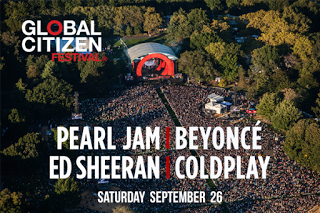
On September 29th, 2012, The Global Citizen Festival was launched on the Great Lawn. The non-profit organization behind the event elected to utilize the glamour of a Central Park concert to raise awareness for global poverty and inequality. Foo Fighters, Neil Young and the Black Keys headlined the inaugural show before a ticketed crowd of 60,000.The most recent concert featured Coldplay, Beyonce, Pearl Jam and Ed Sheeran in 2015. If not the magical, carefree outdoor musical celebration of yesteryear, this seemingly annual event is probably the closest we’ll likely come to recapturing the spectacle of what a Central Park concert used to be. But for those of us lucky enough to have participated in the extravaganza of these open-air performances from the past, there will never be anything quite like the sights and sounds of half-a-million or more, all gathered in one hallowed venue, unified by music.
Poet Of The Wrong Generation by Lonnie Ostrow is now available in paperback and eBook format.
 CLICK HERE TO ORDER YOUR COPY.
CLICK HERE TO ORDER YOUR COPY.
Published on February 15, 2017 08:44
February 1, 2017
Crusin' With Cousin Brucie
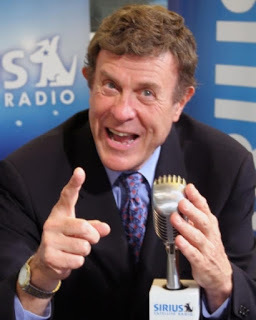
I first met Cousin Brucie in November of 1995. Back then, I was the director of marketing and events for IGPC, the world’s largest postal agency. I was organizing an international postal tribute to John Lennon, marking the 15thanniversary of his assassination. A major event to “unveil” the Lennon stamps at the Hard Rock Café was in the works. A ticket-giveaway promotion with WCBS-FM (NY’s Oldies station) led me to Bruce, who immediately volunteered to MC the festivities. Now, he was coming by to review the event timeline a few weeks early.
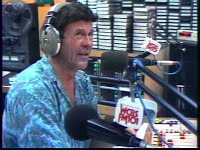 “Hello Cousin Lonnie,” he said in his most endearing radio voice, entering our conference room. “It’s really an honor to be involved in this groovy stamp event. So tell me: what can I do to help you make it even better?”
“Hello Cousin Lonnie,” he said in his most endearing radio voice, entering our conference room. “It’s really an honor to be involved in this groovy stamp event. So tell me: what can I do to help you make it even better?”I found it truly humbling that this icon of the New York airwaves – a radio voice that I (and my parents) had grown up on - was standing before me, addressing me as an honorary “cousin.” Even more impressive was his immediate willingness to roll up his sleeves and offer a helping hand. And boy did he ever!
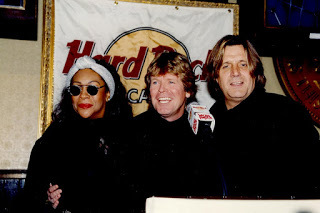 Mary Wilson, Peter Noone and Billy J. Kramer Up to that point, I was scrambling to round up enough high-profile personalities to help participate in the ceremony. We had eight stamps to unveil for eight different governments. I had managed to secure appearances by Mary Wilson (the Supremes), singer Billy J. Kramer, NY Governor, George Pataki, plus a house band to play a set of John Lennon songs. By my scorecard, I was short five celebrity unveilers with only three weeks to go until the big day. Bruce popped open a small black phonebook from the breast pocket of his jacket and started running through some names. “How ‘bout Peter Noone?” he asked. “That guy knew the Beatles from his Herman’s Hermits days. Oh, and what about Leslie Gore? She’s right here in New York.” His smile lit up the room as he flipped through the pages. “And maybe, if we ask nicely, we can get you Dion DiMucci (Dion & the Belmonts).”
Mary Wilson, Peter Noone and Billy J. Kramer Up to that point, I was scrambling to round up enough high-profile personalities to help participate in the ceremony. We had eight stamps to unveil for eight different governments. I had managed to secure appearances by Mary Wilson (the Supremes), singer Billy J. Kramer, NY Governor, George Pataki, plus a house band to play a set of John Lennon songs. By my scorecard, I was short five celebrity unveilers with only three weeks to go until the big day. Bruce popped open a small black phonebook from the breast pocket of his jacket and started running through some names. “How ‘bout Peter Noone?” he asked. “That guy knew the Beatles from his Herman’s Hermits days. Oh, and what about Leslie Gore? She’s right here in New York.” His smile lit up the room as he flipped through the pages. “And maybe, if we ask nicely, we can get you Dion DiMucci (Dion & the Belmonts).”Incredibly, Cousin Brucie’s influence turned out to be even more persuasive than I could have imagined. Not only did he help land those pop stars of yesteryear, but he also hooked me up with famed Beatles concert promoter, Sid Bernstein. And for our stage announcer, he successfully recruited Les Marshak, the voiceover host of every major televised award show in America including the Oscars.
Our jam-packed ceremony on the morning of December 8th, 1995 was the event of the season. Every TV station in NY was on hand. Local, regional and national newspapers too! Flashbulbs popping everywhere. We had each musical presenter perform a John Lennon song with our house band. Cousin Brucie, of course, was front and center. And from this magical day, a special friendship was born.
 Cousin Brucie Interviews The Beatles in 1964Cousin Brucie (Bruce Morrow) began his radio career back in 1959. He made a name for himself in New York on the old WABC AM radio in the early 60s. He got to interview Elvis Presley during a rare visit to NYC, and later, The Beatles for their first American radio interview in 1964. For more than six decades, Bruce has hosted a wide array of Top-40 shows – both national and regional – on AM, FM and now satellite radio. He was a music correspondent on Good Morning America.He appeared as a magician in the 1997 film classic, Dirty Dancing. There’s even a section of 52nd Street in Manhattan named after him.
Cousin Brucie Interviews The Beatles in 1964Cousin Brucie (Bruce Morrow) began his radio career back in 1959. He made a name for himself in New York on the old WABC AM radio in the early 60s. He got to interview Elvis Presley during a rare visit to NYC, and later, The Beatles for their first American radio interview in 1964. For more than six decades, Bruce has hosted a wide array of Top-40 shows – both national and regional – on AM, FM and now satellite radio. He was a music correspondent on Good Morning America.He appeared as a magician in the 1997 film classic, Dirty Dancing. There’s even a section of 52nd Street in Manhattan named after him.In my novel, Poet Of The Wrong Generation, I invented an iconic NY radio personality as a noteworthy supporting character. Larry Jacobs is the program director and afternoon drive host on the fictional WNYR – a man who attempts to help revive the career of our protagonist, Johnny Elias, after his public downfall. Several early readers of my novel, including my editor asked me if I based Larry on anyone in particular. A few suspected that I had Cousin Brucie in mind.
The truth is: There are some parallels between my fictional radio icon and the great Cousin Brucie. Both live downtown in Greenwich Village. Both are aficionados of classic rock & roll. Both are aligned with great charitable causes. However, the personalities are vastly different, as is their physical appearance and domestic situations (Bruce being a happily married family man, while Larry is bitterly divorced). And the real-life Cousin Brucie is a far more charming and a notably more sensible decision maker. But in the similarities column, both men have a keen sense of using the medium of radio for extraordinary, spontaneous promotion.
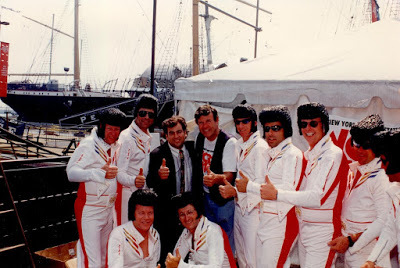 Cousin Brucie and I with The Flying Elvi at Stampfest '96In September of 1996, Bruce served as my on-stage host for StampFest, a postage stamp festival at NY’s South Street Seaport, that drew some 27,000 attendees. Successful as the event was, the ending was shockingly abrupt. Late afternoon hurricane-like conditions suddenly sent the masses scattering… just as the Flying Elvi were skydiving over the East River for our grand finale.
Cousin Brucie and I with The Flying Elvi at Stampfest '96In September of 1996, Bruce served as my on-stage host for StampFest, a postage stamp festival at NY’s South Street Seaport, that drew some 27,000 attendees. Successful as the event was, the ending was shockingly abrupt. Late afternoon hurricane-like conditions suddenly sent the masses scattering… just as the Flying Elvi were skydiving over the East River for our grand finale.I’ll never forget the phone call early the next morning from Cousin Brucie. He roused me from my discouragement and offered to head back down to the Seaport that afternoon to finish up the final performances and ceremony. I raced to get the details organized, then wondered if anyone would bother showing up to witness it.
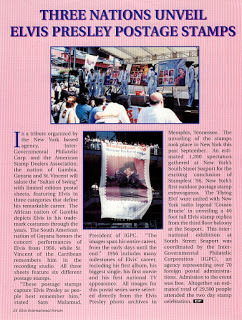 Leave it to Bruce to work his magic. Within minutes of getting the plans together, the “cuz” was phoning in on air at CBS-FM, urging all listeners to head downtown at lunchtime for the Elvis-themed conclusion to the festival. Okay, so we didn’t draw the massive crowd from Sunday. But he did manage to recruit about 400 people on a Monday afternoon to witness the last portion of our unique postal program.
Leave it to Bruce to work his magic. Within minutes of getting the plans together, the “cuz” was phoning in on air at CBS-FM, urging all listeners to head downtown at lunchtime for the Elvis-themed conclusion to the festival. Okay, so we didn’t draw the massive crowd from Sunday. But he did manage to recruit about 400 people on a Monday afternoon to witness the last portion of our unique postal program.Unquestionably, it was this real-life story that help to inspire the heroic promotional efforts of my fictional Larry Jacobs in his attempt to hype the attempted renegade Central Park concert by Johnny Elias. Larry’s masterful on-air publicity on the day of the u
 Poet Of The Wrong Generation by Lonnie Ostrow is now available in paperback and eBook format. CLICK HERE TO ORDER YOUR COPY.
Poet Of The Wrong Generation by Lonnie Ostrow is now available in paperback and eBook format. CLICK HERE TO ORDER YOUR COPY.
Published on February 01, 2017 07:30
January 18, 2017
The LIRR: My Rolling Editorial Office
[image error]
Twenty-two years. That’s how long I’ve been a daily passenger on the Long Island Railroad. I’ve pretty much seen it all over these past two decades. Crazed commuters. Yapping yentas. Cell phone screamers. High stakes card games. Reckless revelers. Ticked-off ticket-takers. I’ve weathered broken trains, busted seats, overcrowded cars, overheated passengers, increased fares and a world of noise. And yet over the past 14 years, I’ve somehow managed to complete a full-length novel on my daily back-and-forth commute aboard America’s busiest railroad.
[image error]
According to Wikipedia, the LIRR averages a weekday ridership of more than 337,000. On some noisy days it feels like there are that many in my train car! The railroad - founded in 1834 - now has 124 stations, more than 700 miles of track, and stretches from the eastern tip of Suffolk County to Manhattan’s Penn Station. It’s also one of the few commuter railroads to operate 24/7. For better or worse, it has been my ride to and from work since 1994.
[image error] Okay, so I’ve got to admit, I didn’t actually write my novel, Poet Of The Wrong Generation, on the train. At least not the first draft. That was done over a three-month span at a desktop computer when I was living in Bayside, Queens in the autumn of 2002. Then came the re-writes. No first novel by any aspiring author is ever publication-ready after the first attempt. Dare I say that the same applies to writers at every level of their career. It’s not just the discovery of typos and missing quotation marks. First drafts are a writer’s best attempt to put the story down on paper. Little did I know that this monumental accomplishment would actually be one of the easier aspects of preparing my novel for publication.
[image error] Re-writes require a great deal of discipline and determination. Also a dose of serious concentration and a more discerning pair of eyes. You find yourself cutting many well-written but unnecessary paragraphs, pieces of research, and sometimes even eliminating a character, or story-line. It can be painful at times, but is entirely necessary.
[image error] When I lived in Bayside, my commute to Penn Station was a mere 17 minutes on average. Hardly the sort of ride that would allow more than a quick peek at a few pages. I vividly recall printing out the full 402 page document and tucking it inside my work bag. This of course was back in the day when tablet computers didn’t exist and laptops were cumbersome to carry. By the time I found a seat and displayed my ticket for the conductor, I had time to peruse perhaps as many as five pages before arriving at Penn. Another five would be read on the way home from the city.
 This early round of editing had me traveling with two different colored pens to make various notations on the pages. Blue was for corrections and new content. Black was used to cross out sentences, or even full paragraphs. And heaven forbid the train ever come to a short stop while I attempted to mark the pages in ink… a discouraging mishap that occurred all-too-often.
This early round of editing had me traveling with two different colored pens to make various notations on the pages. Blue was for corrections and new content. Black was used to cross out sentences, or even full paragraphs. And heaven forbid the train ever come to a short stop while I attempted to mark the pages in ink… a discouraging mishap that occurred all-too-often.
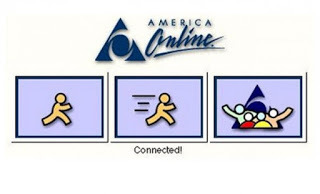 My older daughter, Amber, was not yet two when I took the plunge into this process of becoming a novelist. Her evening schedule required my loving participation. So even with my wife’s very best efforts, I still could not concentrate full-time at home on whipping this novel into shape on my “downtime.” Being a new
My older daughter, Amber, was not yet two when I took the plunge into this process of becoming a novelist. Her evening schedule required my loving participation. So even with my wife’s very best efforts, I still could not concentrate full-time at home on whipping this novel into shape on my “downtime.” Being a new
It took me a full three years of polishing (mostly on the train) before I came to the realization that I needed a professional editor. I had been printing out the document and allowing a few close friends and family members a gander, receiving much encouragement. But when I shared it with some publishing professionals, the feedback wasn’t nearly as complimentary. In fact, it was the kick in the butt that I greatly needed.
[image error] Editor and Author Jeannette de Beauvior Jeannette de Beauvoir is both a published novelist and an experienced editor. I selected her in large part because she had stated on her website that she was a fan of 1970s folk music. We hit it off right away and agreed on three rounds of editing. However, with my busy day-job and continuing parental responsibilities, the train commutes became all the more essential. Now living on Long Island’s south shore, my commute had grown from 17 to 45 minutes each way. Some may have considered this a drawback. In my case, it more than doubled my precious editing time. A fortuitous inconvenience.
[image error] The LIRR passengers have their unofficial code of conduct and routines. Morning commutes tend to be quieter. Especially those prior to 7:30am. Sure, you’ll always get your occasional conversations, although most passengers are respectful of their decibel level. I say “most” because sometimes – particularly on summer Monday mornings – you’ll get some loud out-of-towners who carelessly violate this decorum. And then there are the groups of friendly daily riders who sit in clusters and hold boisterous gossip-fests across the center aisle, drawing angry glares from those trying to rest, or concentrate on work. To be stuck in a four-seater with one of these groups can prove a fate worse than root-canal.
[image error] Afternoon trains tend to be far noisier. Those in the 4pm hour are often packed with construction workers just getting off a jobsite. One can regularly find these burly hard-hats drinking copious amounts of beer, while holding loud, foul mouthed rank-out sessions. Relocation to another car is strongly recommended, even when one isn’t trying to edit a novel. Commuters on afternoon rush hour trains also tend to increase their speaking volume. It can prove an annoyance to those concentrating on work, although it is more tolerated than the morning westbound rides. An investment in an MP3 player and a pair of earbuds is a MUST for those who prefer peace of mind.
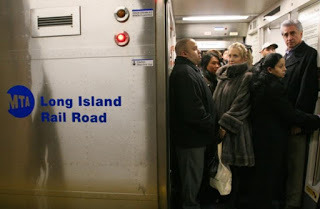 Most riders fall into a routine of catching regular trains home in the evening. Mine became a 6:05 express. I generally ride at the front of the train in order to be closer to my car when pulling into the station. Suffice to say, I encountered an interesting cast of regulars.
Most riders fall into a routine of catching regular trains home in the evening. Mine became a 6:05 express. I generally ride at the front of the train in order to be closer to my car when pulling into the station. Suffice to say, I encountered an interesting cast of regulars.
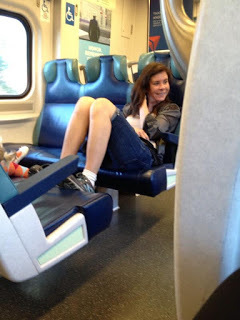 A spry quartet of 60-something men would regularly engage in heated rounds of blackjack with a deck of cards resting on a flattened FedEx box. Serious money was usually at stake. One woman – a wedding planner perhaps – would chat loudly and constantly on her phone about catering and flower arrangements, oblivious to the angry glares of those around her. And then there is one 40-something woman who would call her family and friends each evening, routinely revealing generous personal details including her home address for dinner delivery, and her house alarm code for her forgetful kids to get inside. It is a testament to the morals of daily LIRR commuters that this single-mom and her family weren’t robbed, or physically harmed.
A spry quartet of 60-something men would regularly engage in heated rounds of blackjack with a deck of cards resting on a flattened FedEx box. Serious money was usually at stake. One woman – a wedding planner perhaps – would chat loudly and constantly on her phone about catering and flower arrangements, oblivious to the angry glares of those around her. And then there is one 40-something woman who would call her family and friends each evening, routinely revealing generous personal details including her home address for dinner delivery, and her house alarm code for her forgetful kids to get inside. It is a testament to the morals of daily LIRR commuters that this single-mom and her family weren’t robbed, or physically harmed.
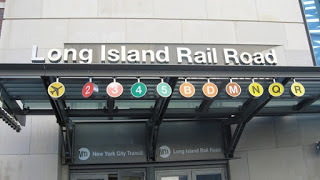
The suggestions from my editor were plugged in at home in my constantly changing Word document. Re-reads of these revisions continued to be conducted along the rickety tracks between Manhattan and Merrick. This process took just over four months to complete. And even after we had deemed it “ready,” I continued to tinker with improving the pages using techniques that she had taught me. Meanwhile, the initiation of a “quiet car” program on the train helped to create a more conducive working environment. It was all falling into place.
[image error] Two years later, I landed a literary agent. I was supplied with a trio of editing reports from the in-house editors and a two month-deadline to implement them. My daily commute was never more valuable. Without those 90 minutes of round-trip revisions, I probably wouldn’t have gotten it completed in time. Not that it mattered in the end.
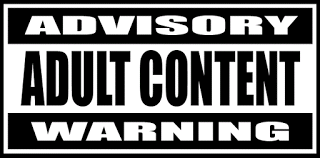 An impasse with my agent over the degree of “adult content” caused me to shelve the project for the past several years. Well, sort of. I never really stopped polishing it. My purchase of a tablet device in 2011 enabled me to resume daily editing without having to schlep piles of printed pages in my work bag. It was on the LIRR that I developed a new ending to the original story. And eventually it became my research headquarters for various publishing options.
An impasse with my agent over the degree of “adult content” caused me to shelve the project for the past several years. Well, sort of. I never really stopped polishing it. My purchase of a tablet device in 2011 enabled me to resume daily editing without having to schlep piles of printed pages in my work bag. It was on the LIRR that I developed a new ending to the original story. And eventually it became my research headquarters for various publishing options.
[image error] It has been a long and arduous journey for me in bringing Poet Of The Wrong Generation to publication. The tracks between New York City and Long Island are figuratively littered with countless sentences, paragraphs and characters cut from the original manuscript. I can’t be certain as to whether my novel is the first to be so thoroughly constructed on the Long Island Railroad. But no doubt, I can’t imagine of another book in which more time was invested by an everyday commuter.
Poet Of The Wrong Generation by Lonnie Ostrow is now available in paperback and eBook format.
CLICK HERE TO ORDER YOUR COPY.
Twenty-two years. That’s how long I’ve been a daily passenger on the Long Island Railroad. I’ve pretty much seen it all over these past two decades. Crazed commuters. Yapping yentas. Cell phone screamers. High stakes card games. Reckless revelers. Ticked-off ticket-takers. I’ve weathered broken trains, busted seats, overcrowded cars, overheated passengers, increased fares and a world of noise. And yet over the past 14 years, I’ve somehow managed to complete a full-length novel on my daily back-and-forth commute aboard America’s busiest railroad.
[image error]
According to Wikipedia, the LIRR averages a weekday ridership of more than 337,000. On some noisy days it feels like there are that many in my train car! The railroad - founded in 1834 - now has 124 stations, more than 700 miles of track, and stretches from the eastern tip of Suffolk County to Manhattan’s Penn Station. It’s also one of the few commuter railroads to operate 24/7. For better or worse, it has been my ride to and from work since 1994.
[image error] Okay, so I’ve got to admit, I didn’t actually write my novel, Poet Of The Wrong Generation, on the train. At least not the first draft. That was done over a three-month span at a desktop computer when I was living in Bayside, Queens in the autumn of 2002. Then came the re-writes. No first novel by any aspiring author is ever publication-ready after the first attempt. Dare I say that the same applies to writers at every level of their career. It’s not just the discovery of typos and missing quotation marks. First drafts are a writer’s best attempt to put the story down on paper. Little did I know that this monumental accomplishment would actually be one of the easier aspects of preparing my novel for publication.
[image error] Re-writes require a great deal of discipline and determination. Also a dose of serious concentration and a more discerning pair of eyes. You find yourself cutting many well-written but unnecessary paragraphs, pieces of research, and sometimes even eliminating a character, or story-line. It can be painful at times, but is entirely necessary.
[image error] When I lived in Bayside, my commute to Penn Station was a mere 17 minutes on average. Hardly the sort of ride that would allow more than a quick peek at a few pages. I vividly recall printing out the full 402 page document and tucking it inside my work bag. This of course was back in the day when tablet computers didn’t exist and laptops were cumbersome to carry. By the time I found a seat and displayed my ticket for the conductor, I had time to peruse perhaps as many as five pages before arriving at Penn. Another five would be read on the way home from the city.
 This early round of editing had me traveling with two different colored pens to make various notations on the pages. Blue was for corrections and new content. Black was used to cross out sentences, or even full paragraphs. And heaven forbid the train ever come to a short stop while I attempted to mark the pages in ink… a discouraging mishap that occurred all-too-often.
This early round of editing had me traveling with two different colored pens to make various notations on the pages. Blue was for corrections and new content. Black was used to cross out sentences, or even full paragraphs. And heaven forbid the train ever come to a short stop while I attempted to mark the pages in ink… a discouraging mishap that occurred all-too-often.  My older daughter, Amber, was not yet two when I took the plunge into this process of becoming a novelist. Her evening schedule required my loving participation. So even with my wife’s very best efforts, I still could not concentrate full-time at home on whipping this novel into shape on my “downtime.” Being a new
My older daughter, Amber, was not yet two when I took the plunge into this process of becoming a novelist. Her evening schedule required my loving participation. So even with my wife’s very best efforts, I still could not concentrate full-time at home on whipping this novel into shape on my “downtime.” Being a new It took me a full three years of polishing (mostly on the train) before I came to the realization that I needed a professional editor. I had been printing out the document and allowing a few close friends and family members a gander, receiving much encouragement. But when I shared it with some publishing professionals, the feedback wasn’t nearly as complimentary. In fact, it was the kick in the butt that I greatly needed.
[image error] Editor and Author Jeannette de Beauvior Jeannette de Beauvoir is both a published novelist and an experienced editor. I selected her in large part because she had stated on her website that she was a fan of 1970s folk music. We hit it off right away and agreed on three rounds of editing. However, with my busy day-job and continuing parental responsibilities, the train commutes became all the more essential. Now living on Long Island’s south shore, my commute had grown from 17 to 45 minutes each way. Some may have considered this a drawback. In my case, it more than doubled my precious editing time. A fortuitous inconvenience.
[image error] The LIRR passengers have their unofficial code of conduct and routines. Morning commutes tend to be quieter. Especially those prior to 7:30am. Sure, you’ll always get your occasional conversations, although most passengers are respectful of their decibel level. I say “most” because sometimes – particularly on summer Monday mornings – you’ll get some loud out-of-towners who carelessly violate this decorum. And then there are the groups of friendly daily riders who sit in clusters and hold boisterous gossip-fests across the center aisle, drawing angry glares from those trying to rest, or concentrate on work. To be stuck in a four-seater with one of these groups can prove a fate worse than root-canal.
[image error] Afternoon trains tend to be far noisier. Those in the 4pm hour are often packed with construction workers just getting off a jobsite. One can regularly find these burly hard-hats drinking copious amounts of beer, while holding loud, foul mouthed rank-out sessions. Relocation to another car is strongly recommended, even when one isn’t trying to edit a novel. Commuters on afternoon rush hour trains also tend to increase their speaking volume. It can prove an annoyance to those concentrating on work, although it is more tolerated than the morning westbound rides. An investment in an MP3 player and a pair of earbuds is a MUST for those who prefer peace of mind.
 Most riders fall into a routine of catching regular trains home in the evening. Mine became a 6:05 express. I generally ride at the front of the train in order to be closer to my car when pulling into the station. Suffice to say, I encountered an interesting cast of regulars.
Most riders fall into a routine of catching regular trains home in the evening. Mine became a 6:05 express. I generally ride at the front of the train in order to be closer to my car when pulling into the station. Suffice to say, I encountered an interesting cast of regulars.  A spry quartet of 60-something men would regularly engage in heated rounds of blackjack with a deck of cards resting on a flattened FedEx box. Serious money was usually at stake. One woman – a wedding planner perhaps – would chat loudly and constantly on her phone about catering and flower arrangements, oblivious to the angry glares of those around her. And then there is one 40-something woman who would call her family and friends each evening, routinely revealing generous personal details including her home address for dinner delivery, and her house alarm code for her forgetful kids to get inside. It is a testament to the morals of daily LIRR commuters that this single-mom and her family weren’t robbed, or physically harmed.
A spry quartet of 60-something men would regularly engage in heated rounds of blackjack with a deck of cards resting on a flattened FedEx box. Serious money was usually at stake. One woman – a wedding planner perhaps – would chat loudly and constantly on her phone about catering and flower arrangements, oblivious to the angry glares of those around her. And then there is one 40-something woman who would call her family and friends each evening, routinely revealing generous personal details including her home address for dinner delivery, and her house alarm code for her forgetful kids to get inside. It is a testament to the morals of daily LIRR commuters that this single-mom and her family weren’t robbed, or physically harmed.
The suggestions from my editor were plugged in at home in my constantly changing Word document. Re-reads of these revisions continued to be conducted along the rickety tracks between Manhattan and Merrick. This process took just over four months to complete. And even after we had deemed it “ready,” I continued to tinker with improving the pages using techniques that she had taught me. Meanwhile, the initiation of a “quiet car” program on the train helped to create a more conducive working environment. It was all falling into place.
[image error] Two years later, I landed a literary agent. I was supplied with a trio of editing reports from the in-house editors and a two month-deadline to implement them. My daily commute was never more valuable. Without those 90 minutes of round-trip revisions, I probably wouldn’t have gotten it completed in time. Not that it mattered in the end.
 An impasse with my agent over the degree of “adult content” caused me to shelve the project for the past several years. Well, sort of. I never really stopped polishing it. My purchase of a tablet device in 2011 enabled me to resume daily editing without having to schlep piles of printed pages in my work bag. It was on the LIRR that I developed a new ending to the original story. And eventually it became my research headquarters for various publishing options.
An impasse with my agent over the degree of “adult content” caused me to shelve the project for the past several years. Well, sort of. I never really stopped polishing it. My purchase of a tablet device in 2011 enabled me to resume daily editing without having to schlep piles of printed pages in my work bag. It was on the LIRR that I developed a new ending to the original story. And eventually it became my research headquarters for various publishing options. [image error] It has been a long and arduous journey for me in bringing Poet Of The Wrong Generation to publication. The tracks between New York City and Long Island are figuratively littered with countless sentences, paragraphs and characters cut from the original manuscript. I can’t be certain as to whether my novel is the first to be so thoroughly constructed on the Long Island Railroad. But no doubt, I can’t imagine of another book in which more time was invested by an everyday commuter.
Poet Of The Wrong Generation by Lonnie Ostrow is now available in paperback and eBook format.
CLICK HERE TO ORDER YOUR COPY.

Published on January 18, 2017 09:22
January 4, 2017
Ray Manzarek of The Doors: The Coolest Rockstar I Almost Met
 Ray Manzarek, Keyboardist of The Doors
Ray Manzarek, Keyboardist of The DoorsOf the many celebrities that I've had the pleasure of knowing, Ray Manzarek was the one I learned the most from. He was sociable, moody, erudite, poetic, energetic, playful, temperamental and wonderfully thoughtful. The coolest rock star I ever met… well almost.
The year was 1997. I had been in the midst of a 7-year magic carpet ride of working with many of my boyhood heroes. My job in those days was director of marketing and PR for an international postal agency called IGPC. I had initiated a program in 1995 that allowed living legends from the world of entertainment to be honored on postage stamps by a handful of lesser-known countries around the world. Before long, every publicist, agent, manager, fan-club, marketing company and some celebrities themselves were pursuing me in an effort to have that next postal honor. It was mind-blowing.
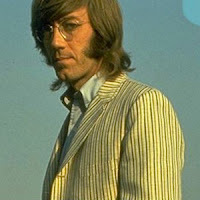 Ray Manzarek in the 1960s The Doors were undoubtedly one of the greatest rock groups of the 1960s. Led by their legendary front-man, Jim Morrison, they made their mark on the pop music world with their psychedelic and bluesy rock sound. Manzarek was the band’s tall, bespectacled keyboard player who supplied them with much of their signature sound – especially on keyboard-heavy classics such as Light My Fire and Touch Me.
Ray Manzarek in the 1960s The Doors were undoubtedly one of the greatest rock groups of the 1960s. Led by their legendary front-man, Jim Morrison, they made their mark on the pop music world with their psychedelic and bluesy rock sound. Manzarek was the band’s tall, bespectacled keyboard player who supplied them with much of their signature sound – especially on keyboard-heavy classics such as Light My Fire and Touch Me. 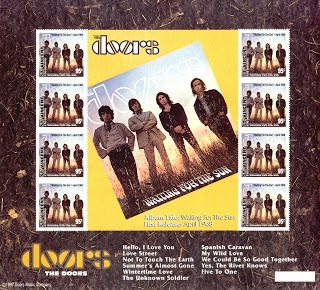 Sometime in mid-1997, I got contacted by a collectible company from New Jersey about a licensing deal celebrating the music of The Doors. They asked me to find them a series of postal administrations to feature their first six album covers on legal tender. Eventually, we settled on six stamps from one nation: St. Vincent & The Grenadines (a Caribbean island). The stamps were designed impressively. They all had to be approved by the band’s manager, a gentleman from Los Angeles by the name of Danny Sugarman. It was a quick turnaround; no complications whatsoever. During this process I had no contact with any of the surviving band members. Nor did I expect to.
Sometime in mid-1997, I got contacted by a collectible company from New Jersey about a licensing deal celebrating the music of The Doors. They asked me to find them a series of postal administrations to feature their first six album covers on legal tender. Eventually, we settled on six stamps from one nation: St. Vincent & The Grenadines (a Caribbean island). The stamps were designed impressively. They all had to be approved by the band’s manager, a gentleman from Los Angeles by the name of Danny Sugarman. It was a quick turnaround; no complications whatsoever. During this process I had no contact with any of the surviving band members. Nor did I expect to.The Doors postage stamps were released in late ’97. I remember drafting a press release, getting it approved by all parties, then sending it out to my list of go-to media contacts. But a funny thing happened along the way. One of my regulars for the celebrity stamp stories was a guy called David Moye, an editor for a satirical news service out in San Diego called Wireless Flash. Mr. Moye called me up upon receipt of my announcement. He promised to run a story, but something in his voice that day suggested that he had a much bigger idea.
 Journalist, David Moye As it turned out, David Moye was a personal friend of Ray Manzarek. He told me that no story would be complete without a quote from one of the living band members, so he would be contacting him for a sound byte. Later that evening, Mr. Moye phoned me back. He could hardly contain his excitement. “Lonnie, not only did Ray give me some quotes for the feature, but he’s really keen on these Doors stamps. He’s asking to talk to you; wants to maybe do something special to promote them.”
Journalist, David Moye As it turned out, David Moye was a personal friend of Ray Manzarek. He told me that no story would be complete without a quote from one of the living band members, so he would be contacting him for a sound byte. Later that evening, Mr. Moye phoned me back. He could hardly contain his excitement. “Lonnie, not only did Ray give me some quotes for the feature, but he’s really keen on these Doors stamps. He’s asking to talk to you; wants to maybe do something special to promote them.”The very next day, I had a home phone number for a rock legend with an invitation to call him up. It was his wife, Dorothy who answered when I called. She passed the phone to Ray, who couldn’t have been friendlier. “So I was thinking, maybe you and I could help each other out. You see, I know you’re looking to promote our stamps, which are way cool. But I’ve got this other project going on that I’m trying to hype. I’m thinking that maybe you can book me on a few shows where I can plug both the stamps and my new memoir, which is about to be published.”
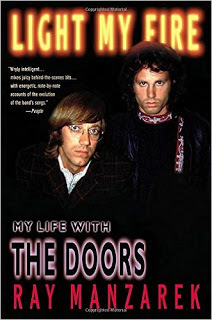 Manzarek had written a book called: Light My Fire: My Life With The Doors. David Moye had told him of my considerable publicity skills. The rock legend saw this as an opportunity to potentially co-promote two projects at once. I was only too willing to play along. I sent out an alert to some 60 rock-radio morning shows across the US, offering Ray Manzerek as an interview guest, plus a set of the Doors stamps as an on-air giveaway. I immediately drew interest from some 20 stations. I phoned back Ray with the details.
Manzarek had written a book called: Light My Fire: My Life With The Doors. David Moye had told him of my considerable publicity skills. The rock legend saw this as an opportunity to potentially co-promote two projects at once. I was only too willing to play along. I sent out an alert to some 60 rock-radio morning shows across the US, offering Ray Manzerek as an interview guest, plus a set of the Doors stamps as an on-air giveaway. I immediately drew interest from some 20 stations. I phoned back Ray with the details.“So I’m really impressed. But I’m not gonna take all of ‘em. Sure, I’ll do the big markets. Also the west coast shows where I’m in the same time zone. But I’m passing on the smaller east coast gigs. No way I’m getting up at 4am to talk to ten listeners in South Carolina.”
The radio spots were all a success. Ray would call me after each one to give me the interview highlights. As we progressed with the promotion, he began to treat me like a friend. He offered to sign sets of the Doors stamps sheets, and even gave me his home address in Beverly Hills to send over packages by FedEx. At one point, I remember him asking me if I was a fan of The Doors. When I answered affirmatively, he told me I could ask him any question I wanted about the band.
“So what was your take on the Oliver Stone movie of The Doors?”
 “Next question!” he answered sharply. After we both had an awkward laugh, he went on a ten minute diatribe about how much Oliver Stone had distorted the personalities of the band members. “I loved the attention that the movie generated for us and our music, but let’s just say that I wasn’t a fan of the depiction of us.”
“Next question!” he answered sharply. After we both had an awkward laugh, he went on a ten minute diatribe about how much Oliver Stone had distorted the personalities of the band members. “I loved the attention that the movie generated for us and our music, but let’s just say that I wasn’t a fan of the depiction of us.”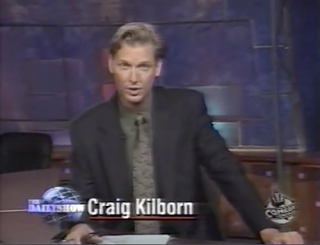 One of the big early bookings that I got for Ray was a phone-in segment on Comedy Central’s The Daily Show with Craig Kilborn. I don’t own a clip of the show from that night, but I remember it going horribly wrong. An audio glitch occurred from the start of the interview that prevented Ray from hearing the questions from the host. He started talking about the stamps, but then lost his temper (on live TV) when he couldn’t hear Kilborn’s questions. Eventually, he started cursing a blue streak (which was bleeped out on 7-second delay). He hung up in frustration. The studio audience couldn’t control their laughter. It was a disaster… or so I thought.
One of the big early bookings that I got for Ray was a phone-in segment on Comedy Central’s The Daily Show with Craig Kilborn. I don’t own a clip of the show from that night, but I remember it going horribly wrong. An audio glitch occurred from the start of the interview that prevented Ray from hearing the questions from the host. He started talking about the stamps, but then lost his temper (on live TV) when he couldn’t hear Kilborn’s questions. Eventually, he started cursing a blue streak (which was bleeped out on 7-second delay). He hung up in frustration. The studio audience couldn’t control their laughter. It was a disaster… or so I thought. I wasn’t sure I’d ever hear back from Ray after the Daily Show debacle. But late the next morning, he was calling my office. I was hesitant to pick up his call. But I nervously grabbed it after the second ring, awaiting an eruption that never came.
“Lonnie, you won’t believe how many people have been calling us this morning about that show from last night. I had no idea so many people even watched that cable network. I haven’t had this much attention in years! Everyone we know has been ringing us since that screw-up from last night. It’s wild.”
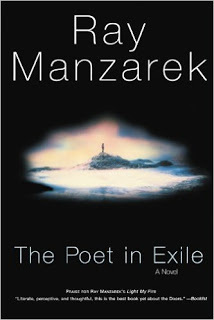 I probably spoke to Ray Manzarek some twenty times by phone over the next several months. In addition to my booking him for media appearances, he also enjoyed bouncing some ideas off me for future projects. One of them was a novel he was writing entitled, The Poet In Exile. It was a fantasy story where Jim Morrison had faked his own death and was living on some remote island, keeping tabs on the music world. It wasn’t particularly good, though I appreciated the sentiment of Ray keeping his fallen band-mate alive for a last reunion. He’d even sent me the unedited manuscript to review.
I probably spoke to Ray Manzarek some twenty times by phone over the next several months. In addition to my booking him for media appearances, he also enjoyed bouncing some ideas off me for future projects. One of them was a novel he was writing entitled, The Poet In Exile. It was a fantasy story where Jim Morrison had faked his own death and was living on some remote island, keeping tabs on the music world. It wasn’t particularly good, though I appreciated the sentiment of Ray keeping his fallen band-mate alive for a last reunion. He’d even sent me the unedited manuscript to review.Regrettably, I never did get to meet Ray in person, though it almost happened in June of 1998. He had flown to New York to attend a memorial service for Linda McCartney to which he had been invited. I was traveling that week at a postal exhibition on the west coast, unaware that Ray was in my hometown. I had quite the surprise when I returned.
Toby, our lovely, redheaded
“Lonnie, sorry I missed you. I thought I’d surprise you by saying hello in person. Maybe next time. Best wishes from your friend Ray.”
There never would be a next time. Not in person, anyway. But I continued to speak with Ray by phone sporadically over the next few years. In 2001, after I’d left my job at IGPC, I’d called him to let him know that I was looking for the next phase in my career. His response was unhelpful, but priceless.
 The Doors 21st Century Reunion Lineup“So how’s your singing voice? Robbie, John and I are thinking about going back on the road as the Doors again for some shows. If you can sing like Jim Morrison, well I might have you audition.”
The Doors 21st Century Reunion Lineup“So how’s your singing voice? Robbie, John and I are thinking about going back on the road as the Doors again for some shows. If you can sing like Jim Morrison, well I might have you audition.”In 2002, I penned the first draft of my debut novel, Poet Of The Wrong Generation. There is a sequence midway through the story where my fictional rock star, Johnny Elias would be out in Los Angeles, recording a second album with his band, trying to match the immense success of his first recording. As the author, I wanted to insert a real rock legend based in L.A. who could randomly run into Johnny and share some career advice and offer validation of his success. Immediately, I thought of Ray. A musical icon for sure, but not someone who would be so easily recognized by casual fans. The scene is a short one, though I took the liberty of putting a few words of encouragement in Ray’s mouth. I mailed him the pages of the scene, along with a note summarizing my book. He phoned me up some weeks later.
“So, when I first saw your book title, I thought you were ripping off ThePoet In Exile (his Jim Morrison inspired novel). But then I read the scene you sent me and realized this is totally different. Anyway, it’s all cool with me. I’m kinda flattered that you thought to stick me in your story. When do I get to read the rest of it?”
I later sent a box to Ray containing the complete manuscript. And though I never heard back from him with his feedback, I had every intention of seeking him out upon publication of the novel to get a promotional quote. Sadly, this was not to be.
It took me 14 long years to finally bring my novel to print after years of life’s ups and downs. Between a busy career, raising two kids, endless editing, and an array of setbacks, an earlier release was simply not possible.
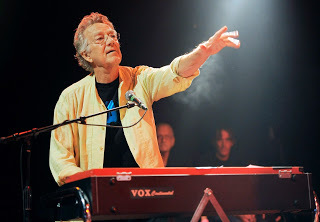 Ray Manzarek died suddenly in 2013 after a short illness. He was 73 and had been musically active to the end. It would have been a great joy for me to have shared a signed copy of my novel with my legendary “friend” after all the stamp sheets and books he had signed for me. Even sweeter would have been the opportunity to do it in person, an event that unfortunately eluded us both. Still, I will always cherish the relationship he and I shared by phone and FedEx back in the late 1990s. A truly terrific character who I am proud to honor with a scene in my novel that I know he was genuinely tickled by. It now serves as a fitting tribute.
Ray Manzarek died suddenly in 2013 after a short illness. He was 73 and had been musically active to the end. It would have been a great joy for me to have shared a signed copy of my novel with my legendary “friend” after all the stamp sheets and books he had signed for me. Even sweeter would have been the opportunity to do it in person, an event that unfortunately eluded us both. Still, I will always cherish the relationship he and I shared by phone and FedEx back in the late 1990s. A truly terrific character who I am proud to honor with a scene in my novel that I know he was genuinely tickled by. It now serves as a fitting tribute.Poet Of The Wrong Generation by Lonnie Ostrow is now available in paperback and eBook format. Order your copy today.

Published on January 04, 2017 07:00
December 22, 2016
The Unseen Side Of Celebrity
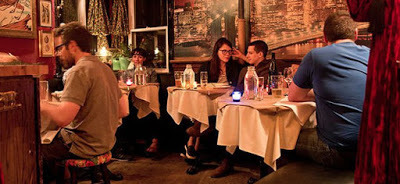 Star-struck. Awed. Nervous. Giddy. These are a few of the words that come to mind when I think back on my early encounters with celebrities. From the time I was six years of age, I have had the unique privilege and good fortune of a wide array of celebrity sightings. Some were by chance at restaurants, airports, a parking garage, and on the streets of New York City. Others were planned at autograph signings, and later at countless events that I organized professionally. I remember every one of them as if they occurred just minutes ago. But it is one extraordinary brush with an icon that forever changed my perception of celebrity mythology. One that humanized the whole lofty experience.
Star-struck. Awed. Nervous. Giddy. These are a few of the words that come to mind when I think back on my early encounters with celebrities. From the time I was six years of age, I have had the unique privilege and good fortune of a wide array of celebrity sightings. Some were by chance at restaurants, airports, a parking garage, and on the streets of New York City. Others were planned at autograph signings, and later at countless events that I organized professionally. I remember every one of them as if they occurred just minutes ago. But it is one extraordinary brush with an icon that forever changed my perception of celebrity mythology. One that humanized the whole lofty experience.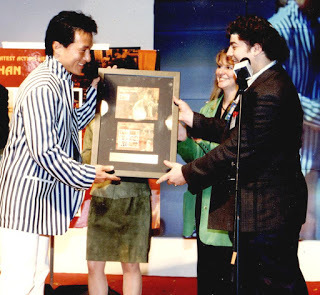 Lonnie Ostrow presents Jackie Chan with his postage stamps It was March of 1997. I was employed as the director of marketing and publicity for an agency that created postage stamps for governments around the world. A few years earlier, I had stumbled upon the phenomenon of placing living legends on legal tender for a handful of counties across the globe. It had become a worldwide media sensation. Already, I had the pleasure of working with such luminaries as Jackie Chan, Sylvester Stallone, Elle Macpherson and Bob Hope. Now, I was being courted by celebrity publicists on both coasts, seeking to honor their famous clients as the next living postal icon.
Lonnie Ostrow presents Jackie Chan with his postage stamps It was March of 1997. I was employed as the director of marketing and publicity for an agency that created postage stamps for governments around the world. A few years earlier, I had stumbled upon the phenomenon of placing living legends on legal tender for a handful of counties across the globe. It had become a worldwide media sensation. Already, I had the pleasure of working with such luminaries as Jackie Chan, Sylvester Stallone, Elle Macpherson and Bob Hope. Now, I was being courted by celebrity publicists on both coasts, seeking to honor their famous clients as the next living postal icon.My interactions with the stars I had worked with up to that point ranged from brief, goose-bump raising meetings to extensive and direct planning (and celebrating) with other heroes. Some were remarkably insulated by assistants and PR reps. Others freely shared private phone numbers and were surprisingly accessible. But in my mind, no matter how professionally I learned to act on the outside, there was always a twinge of giddiness at the thought of being in the presence of such beloved public figures.
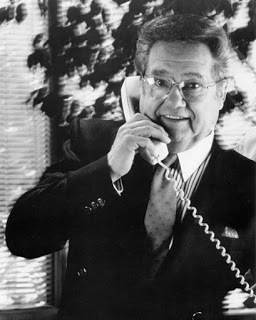 Legendary publicist, Warren Cowan Warren Cowan was no ordinary celebrity publicist. When he first phoned me in January of ’97, he introduced himself as the “representative of Hollywood’s greatest legends.” And this was no hype job. Mr. Cowan had been publicizing the biggest names in entertainment going back to 1946. He was a founding partner of the powerhouse publicity agency, Rogers and Cowan. Some of his impressive list of clients once included Paul Newman, Danny Kaye, Ronald Reagan, Judy Garland, Joan Crawford, Frank Sinatra and John Wayne (to name a few). In 1994 – two years after he sold off the agency – he was lured out of retirement by a handful of his celebrated clients. He quoted Elizabeth Taylor as saying: “Warren, it’s you that I want representing me, not the Rogers and Cowan name.”
Legendary publicist, Warren Cowan Warren Cowan was no ordinary celebrity publicist. When he first phoned me in January of ’97, he introduced himself as the “representative of Hollywood’s greatest legends.” And this was no hype job. Mr. Cowan had been publicizing the biggest names in entertainment going back to 1946. He was a founding partner of the powerhouse publicity agency, Rogers and Cowan. Some of his impressive list of clients once included Paul Newman, Danny Kaye, Ronald Reagan, Judy Garland, Joan Crawford, Frank Sinatra and John Wayne (to name a few). In 1994 – two years after he sold off the agency – he was lured out of retirement by a handful of his celebrated clients. He quoted Elizabeth Taylor as saying: “Warren, it’s you that I want representing me, not the Rogers and Cowan name.”Within months of opening Warren Cowan Associates in Beverly Hills, Mr. Cowan again represented a vast majority of Hollywood’s most iconic names of yesteryear. They all gravitated back to him.
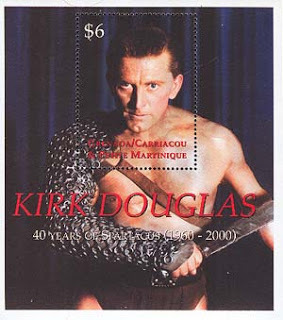 It was Kirk Douglas that Mr. Cowan first approached me about for a postage stamp tribute. We were creeping up on the 40th anniversary of his landmark film, Spartacus. The veteran publicist called to pitch me on the idea. A month later, he was to be in New York for a pair of client events. The first was a book launch party at Le Cirquerestaurant by the renowned author, Sidney Sheldon, to which he invited me. Two days later, he phoned my office, asking me to meet with him at his suite at the St. Regis hotel.
It was Kirk Douglas that Mr. Cowan first approached me about for a postage stamp tribute. We were creeping up on the 40th anniversary of his landmark film, Spartacus. The veteran publicist called to pitch me on the idea. A month later, he was to be in New York for a pair of client events. The first was a book launch party at Le Cirquerestaurant by the renowned author, Sidney Sheldon, to which he invited me. Two days later, he phoned my office, asking me to meet with him at his suite at the St. Regis hotel. 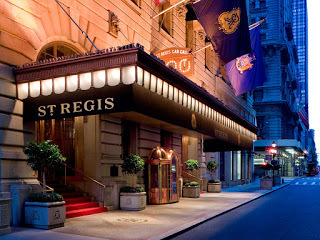 The sheer opulence of the hotel immediately grabbed my attention. I had previously been inside some impressive Hyatts and Marriots. Even once the Four Seasons for a meeting with David Copperfield. But the classic luxury of this chic retreat on East 55thStreet was truly captivating. Up in the room, I was immediately led by one of Mr. Cowan’s staffers to a waiting area that resembled the most impressive living room I’d ever seen in person. I sat patiently (and rather comfortably) on a button-leather couch, next to a shinny marble coffee table beneath a huge crystal chandelier. Far across the room, I watched Mr. Cowan and his associates in action, pitching the news media on coverage for an event they had run the night before. For a young publicist like me, it was breathtaking to see their skills of persuasion on display.
The sheer opulence of the hotel immediately grabbed my attention. I had previously been inside some impressive Hyatts and Marriots. Even once the Four Seasons for a meeting with David Copperfield. But the classic luxury of this chic retreat on East 55thStreet was truly captivating. Up in the room, I was immediately led by one of Mr. Cowan’s staffers to a waiting area that resembled the most impressive living room I’d ever seen in person. I sat patiently (and rather comfortably) on a button-leather couch, next to a shinny marble coffee table beneath a huge crystal chandelier. Far across the room, I watched Mr. Cowan and his associates in action, pitching the news media on coverage for an event they had run the night before. For a young publicist like me, it was breathtaking to see their skills of persuasion on display. Mr. Cowan finally sat to join me and offered to order up some tea and finger sandwiches from room-service. Then we got down to business. For thirty solid minutes, we talked about his incomparable list of clients, trying to match them with my list of governments who might consider a postal tribute to them. He spoke about Paul Newman’s charitable work; Kirk Douglas and some playgrounds he was building for underprivileged kids. He even floated the idea of a joint postal celebration for Jack Lemmon and Walter Matthau for their many co-starring projects. We were midway through our productive conversation when the unforgettable happened.
Mr. Cowan finally sat to join me and offered to order up some tea and finger sandwiches from room-service. Then we got down to business. For thirty solid minutes, we talked about his incomparable list of clients, trying to match them with my list of governments who might consider a postal tribute to them. He spoke about Paul Newman’s charitable work; Kirk Douglas and some playgrounds he was building for underprivileged kids. He even floated the idea of a joint postal celebration for Jack Lemmon and Walter Matthau for their many co-starring projects. We were midway through our productive conversation when the unforgettable happened.A door at the far end of the living room swung open. It connected to an adjoining suite which I hadn’t noticed previously. In walked an older woman in a white hotel bathrobe and a pair of matching white slippers. Her short-cropped curly hair was white and tussled. Her naked face was heavily lined and marked with age spots. Slowly, she approached the leather couch and paused at the foot of the coffee table. “Oh, Warren dear,” she said in low voice with the hint of an English accent. “Sorry to interrupt. I didn’t realize you had company. We’ll catch up later.” She raised her hand, flashed a brief smile and casually strolled back through the connecting door to her suite.
 Elizabeth Taylor in 1997 There was nothing glamorous about this brief intrusion. The woman from next door wore no makeup, no jewelry, or fancy clothing. She could have been anyone’s grandma, having just rolled out of bed in the early afternoon. But there was one unique detail that failed to elude my attention. As she turned around to head back in the opposite direction, I noticed her eyes. They were shining a deep blue, almost violet beneath the overhead chandelier. There is only one woman I’ve ever known to have such eye pigmentation. And she just happened to be the one whose fundraising event Mr. Cowan and his staff had hosted just the night before. Elizabeth Taylor.
Elizabeth Taylor in 1997 There was nothing glamorous about this brief intrusion. The woman from next door wore no makeup, no jewelry, or fancy clothing. She could have been anyone’s grandma, having just rolled out of bed in the early afternoon. But there was one unique detail that failed to elude my attention. As she turned around to head back in the opposite direction, I noticed her eyes. They were shining a deep blue, almost violet beneath the overhead chandelier. There is only one woman I’ve ever known to have such eye pigmentation. And she just happened to be the one whose fundraising event Mr. Cowan and his staff had hosted just the night before. Elizabeth Taylor.“Was that - ” I attempted to ask, before being hastily cut off by my host.
“Yes,” he confirmed without uttering her name. “But she was never here and you saw nothing,” he insisted. “This didn’t happen.”
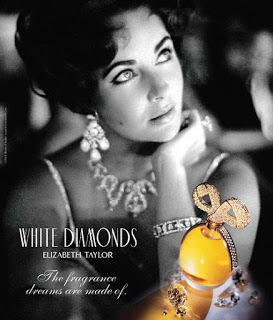 Elizabeth Taylor was always synonymous with glamour. Many consider her to have been the most beautiful actress that Hollywood has ever known. She was a style icon, always decked out in the most exquisite gowns designed by the biggest names in fashion. She was forever covered in diamonds and colorful jewels from her many husbands and suitors through the decades. Even her signature fragrance was called White Diamonds. And yet here she was, just steps away from me, appearing as plain and imperfect as any woman her age (65 at the time). It was both mind-boggling, and yet oddly reassuring. She was human.
Elizabeth Taylor was always synonymous with glamour. Many consider her to have been the most beautiful actress that Hollywood has ever known. She was a style icon, always decked out in the most exquisite gowns designed by the biggest names in fashion. She was forever covered in diamonds and colorful jewels from her many husbands and suitors through the decades. Even her signature fragrance was called White Diamonds. And yet here she was, just steps away from me, appearing as plain and imperfect as any woman her age (65 at the time). It was both mind-boggling, and yet oddly reassuring. She was human.Most of my interactions with celebrities have taken place in public settings. Never a hair out of place. Always impeccably dressed and camera-ready. Even during private meetings, it was rare for me to encounter any of these stars as anything less than what you would expect them to look like. Image consciousness is like a sixth sense to them. So to my utter surprise, here was my first time crossing paths with the world’s queen of glamour. And she appeared as ordinary as could be imagined.
In my novel, Poet Of The Wrong Generation, I do my utmost to portray both sides of celebrity. The myth vs. reality. My protagonist, Johnny Elias is a young man who has been seduced by the concept of music stardom since childhood. From his vantage-point as a fan, there is nothing more glorious than the life of a rock star. And then he hits the big-time… and hastily discovers the demands and responsibilities of life in the public eye – nothing at all like he envisioned. Sure, he experiences the loud ovations and a taste of privilege. But media intrusions and pressure from his record label and tour promoters threaten to swallow him whole.
In reality, the life beyond the red carpet and the press conferences are vastly different than many imagine. Yes, there are some major perks that come with stardom -- wealth and admiration being two of them. Then again, even the highest paid entertainers are constricted by life’s limitations. They may be blessed with exceptional talent, but aren’t granted superpowers or immortality. Like all of the non-famous population, celebrities still need a decent night’s sleep, a healthy diet, and stable companionship at home. They may have stylists, publicists and fitness gurus to help sculpt their public persona. Then they step off-stage. Real life for them presents the same challenges that we all face every day. Aging, health, taxes, family and maintaining a home. They too have to figure out how to balance it all over the course of 24-hour days.
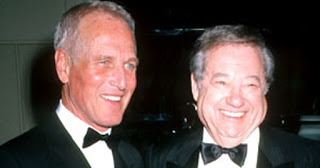 Paul Newman with Warren Cowan Just after Elizabeth Taylor tiptoed back to her suite, Warren Cowan shared with me a handful of incidents in which he encountered many of his most famous clients in less than flattering situations. There was the night he schlepped a case of tissues, cough syrup and gallons of chicken soup to the home of one of his actress clients who was battling the flu. He recounted an early morning when he had to run out and hand cash to a famous actor stranded at a gas station after discovering that he’d misplaced his wallet. And then there was an award-winning actress who he helped to move out of a hostile living situation under the watchful glare of her soon-to-be ex-husband. “Like you and me, they all have everyday problems. Theirs are just more magnified when the public catches on,” he explained.
Paul Newman with Warren Cowan Just after Elizabeth Taylor tiptoed back to her suite, Warren Cowan shared with me a handful of incidents in which he encountered many of his most famous clients in less than flattering situations. There was the night he schlepped a case of tissues, cough syrup and gallons of chicken soup to the home of one of his actress clients who was battling the flu. He recounted an early morning when he had to run out and hand cash to a famous actor stranded at a gas station after discovering that he’d misplaced his wallet. And then there was an award-winning actress who he helped to move out of a hostile living situation under the watchful glare of her soon-to-be ex-husband. “Like you and me, they all have everyday problems. Theirs are just more magnified when the public catches on,” he explained.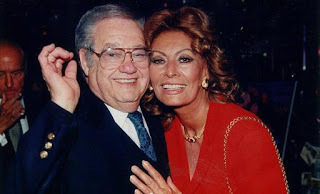 Warren Cowan with Sophia Loren Throughout the course of my twenty years in working with celebrities, I’ve come to experience many similar incidents. I’ve booked emergency dentist appointments, arranged cleaning services, driven them to events and provided early-morning wake-up calls. And I’ve witnessed them in private moments of triumph, sadness, anger and hilarity. The same range of emotions that we all experience in our “real lives.” There’s a line a former employer of mine often used about celebrities; about how just like us, they put on their pants each morning “one leg at a time.” Or, in the case of the late, great Elizabeth Taylor, we all roll out of bed each day equally disheveled and imperfect. It’s a common trait that bonds us as ordinary humans – some a bit more renown than others.
Warren Cowan with Sophia Loren Throughout the course of my twenty years in working with celebrities, I’ve come to experience many similar incidents. I’ve booked emergency dentist appointments, arranged cleaning services, driven them to events and provided early-morning wake-up calls. And I’ve witnessed them in private moments of triumph, sadness, anger and hilarity. The same range of emotions that we all experience in our “real lives.” There’s a line a former employer of mine often used about celebrities; about how just like us, they put on their pants each morning “one leg at a time.” Or, in the case of the late, great Elizabeth Taylor, we all roll out of bed each day equally disheveled and imperfect. It’s a common trait that bonds us as ordinary humans – some a bit more renown than others. Poet Of The Wrong Generation by Lonnie Ostrow is now available in paperback and eBook format. CLICK HERE TO ORDER YOUR COPY.
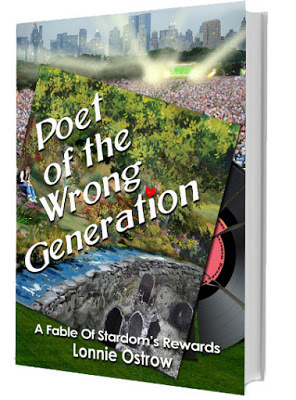
Published on December 22, 2016 06:56

